Bangladesh is underlain by the Bengal delta, which formed by deposition of sediments
from the Ganges, Brahmaputra and Meghna Rivers. The sediment is mainly sand and silt from
the Himalayan highlands. The delta has a monsoonal climate, with alternating wet and dry
seasons. The sedimentation rate is rapid, approximately 0.2 cm yr -1. .
Various facies of deposition can be seen within the alluvial fan deltas, fluvial flood plains and deltaic environments. Fine-grained deposits were laid down during periods with a relatively high sea level and corre-spondingly
low-energy environment (so-called 'high-stand'deposits) whereas coarse-grained deposits characteristic of a high-energy environment formed during periods of glacial maximum or 'low-stand' times.
As far as Bangladesh is concerned, the risk factor associated with water availability is one of ominous significance. Despite being a riverine country, 57 trans-boundary rivers of this country originate from different points in India while the rest are from Myanmar.
Bangladesh already suffers a great deal of water related problems like arsenic poisoning (61 out of 64 districts are now affected), flooding, drought and river bank erosion most of which is due to man-made intervention like that of Farakka Dam along with constantly suffering from the effects of unequal distribution of Ganges's water which breaches the water distribution accord that was made with India in 1975.
The delegates from Bangladesh in the recent WWF meeting in Istanbul earnestly addressed many of these issues. But the greatest threat lies on India's ambition to construct the River Linking Project (RLP) which plans to interlink Himalayan Rivers and divert their flows to the western and southern states of India which experts believe that in effect will put Bangladesh into the brink of serious environmental, economical and social disaster by drastically decreasing the water flow of sub-rivers of the country's north-western regions, north-central regions, south-western regions and south-central regions. Dhaka also has its fair share of the sufferings, the testimony of which could be given by almost each of its residents. Against the demand of 1.6 billion litres per day, WASA currently has the capacity of supplying 1.27 billion litres of water for the residents of the capital and as the ground water levels are falling by nearly six feet each year, many of the 750 deep tube-wells of WASA will eventually be unable to pump out water as they won't be able to reach to the deepening underwater reservoirs. This is bad news for the city's 12.3 million residents.
Add to that is the growing threat from the impact of the climate change and rise in the sea levels which many fear would have disastrous effect on Bangladesh.
Arsenic - mass poisoning on an unprecedented scale
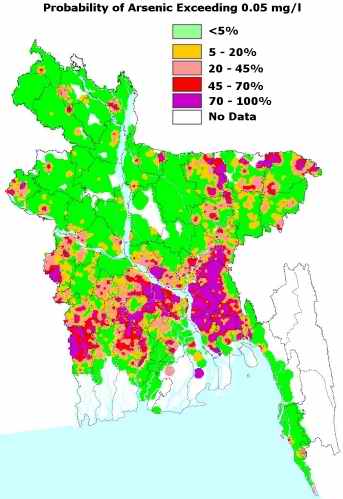 Geneva: The largest mass poisoning of a population in history is now underway in Bangladesh.
It is a terrible public catastrophe, asserts Allan H. Smith, Professor of Epidemiology at the University of California, Berkeley, and a WHO consultant who has investigated arsenicosis in Bangladesh on several trips.
The number of people affected by this arsenic disaster is among the greatest of any disease facing the world today. "By virtue of its sheer size it is pushing the limits of our knowledge and capacity to respond to it," asserts Professor Hans van Ginkel, Rector of the United Nations University in Tokyo.
The crisis has, however, spurred intense research in water de-contamination techniques - how to ensure tens of millions of people arsenic-free drinking water when their water supply comes from wells, many of them rich in arsenic.
How many Bangladeshis are exposed to a high level of arsenic? Geneva: The largest mass poisoning of a population in history is now underway in Bangladesh.
It is a terrible public catastrophe, asserts Allan H. Smith, Professor of Epidemiology at the University of California, Berkeley, and a WHO consultant who has investigated arsenicosis in Bangladesh on several trips.
The number of people affected by this arsenic disaster is among the greatest of any disease facing the world today. "By virtue of its sheer size it is pushing the limits of our knowledge and capacity to respond to it," asserts Professor Hans van Ginkel, Rector of the United Nations University in Tokyo.
The crisis has, however, spurred intense research in water de-contamination techniques - how to ensure tens of millions of people arsenic-free drinking water when their water supply comes from wells, many of them rich in arsenic.
How many Bangladeshis are exposed to a high level of arsenic?
Estimates vary from a low of 28-35 million to a high of 77 million, more than half the population of the country.
The Bangladeshis are being poisoned by drinking well water, usually without knowing it. Only three decades ago health and development experts, and small local contractors, dug between 7-11 million deep tubewells throughout Bangladesh. The experts encouraged the whole nation to drink well water because it was safe. It was free of the bacteria that caused water-borne diseases such as diarrhoea and other intestinal maladies that have long plagued tropical Bangladesh.
WHO's most recent guideline for a maximum amount of arsenic in drinking water recommends 10 parts per billion (ppb). That was in 1993 when it was lowered to that level from 50 ppb. A new guideline is anticipated in 2003. But most water that is drunk in arsenic-affected areas in Bangladesh has substantially higher levels, frequently far above 50 ppb.
Arsenic-contaminated water is not restricted to developing countries. In the western states of the United States of America about 13 million people drink arsenic-tainted water, albeit less contaminated than the well water in Bangladesh. Australia, too, has arsenic-contaminated water. So do Argentina, Brazil, Chile, Hungary, Mexico, Taiwan, Thailand, Viet Nam, and the eastern areas of India in Bengal.
"Unfortunately," says WHO sanitary engineer, Hiroki Hashizume, a Japanese expert on arsenic, "it is virtually impossible, with present measurement techniques, especially in the developing world, to measure quantities below 10 ppb. When drinking water guidelines or national standards are established, careful attention has to be paid to analytical capability, arsenic removal technology, etc., to ensure that the levels are really achieved. Since the principal health gain comes from targeting those most exposed to arsenic poisoning, using an intermediate target of 50 ppb, until a lower target can be achieved, would already improve people's health given Bangladesh's limitations."
"Another unfortunate and complicating fact about arsenic poisoning," Hiroki Hashizume adds, "is that it generally takes from seven to 10 years, sometimes longer, for the disease to be recognised. When it finally is, it may be too late to treat."
Professor Robert Goyer, who headed a nine-member commission of the US National Academies of Science, says its findings bolster a 1999 study by the Academy that found that men and women who drink every day water with 10 ppb of arsenic have an increased risk of more than 3 in 1000 of developing bladder or lung cancer during their lifetime. That risk rises to 7 in 1000 at 20 ppb.
Arsenicosis is recognisable from skin colour changes, blotches all over the face and body, hyper pigmentation on the chest and upper arms, hard patches on palms and soles of the feet, inability to walk, debilitating pain, watery eyes.
Source: Holiday, A WHO feature marking the World Water Day observed on 22 March 2005.
|
Back to Content
At least 1.1 billion lack access to safe drinking-water
 At the beginning of this 21st century, the World Health Organisation estimated that of the world's six billion people, at least 1.1 billion lack access to safe drinking-water and 2.4 billion are living without access to sanitation systems. An estimated 14 to 30 thousand people, mostly young and elderly, die everyday from avoidable water-related diseases (e.g. diarrhoeal diseases). The lives of these people who are among the poorest on our planet are often devastated by this deprivation, which impedes the enjoyment of health and other human rights. Water is a limited natural resource and fundamental for life and health.
At the beginning of this 21st century, the World Health Organisation estimated that of the world's six billion people, at least 1.1 billion lack access to safe drinking-water and 2.4 billion are living without access to sanitation systems. An estimated 14 to 30 thousand people, mostly young and elderly, die everyday from avoidable water-related diseases (e.g. diarrhoeal diseases). The lives of these people who are among the poorest on our planet are often devastated by this deprivation, which impedes the enjoyment of health and other human rights. Water is a limited natural resource and fundamental for life and health.
"The human right to water entitles everyone to sufficient, safe, acceptable, physically accessible and affordable water for personal and domestic uses. An adequate amount of safe water is necessary to prevent death from dehydration, reduce the risk of water-related disease and provide for consumption, cooking, personal and domestic hygienic requirements". This is what the United Nations' Human Rights statement reads on Right to Water (adapted on November 26, 2002). All member countries including India, are supposed to respect, protect and fulfil this human right to water of their citizens.
"Access to safe water is a fundamental human need and therefore a basic human right" said UN Secretary General Kofi Annan. "In this new century, water, its sanitation, and its equitable distribution, pose great social challenges for our world. We need to safeguard the global supply of healthy water and to ensure that everyone has access to it."
Moreover numerous fundamental human rights cannot be fully realised without water. For example, without water, no life can be sustained, and therefore Right to Life can never be respected, protected or fulfilled unless we stop ignoring right to water. Similarly water being essential for farming and cooking, right to food can't be enjoyed unless we recognise the right to water. Almost 70 percent of all mobilised freshwater is used for agriculture and it is estimated that more than one third of global food production is based on irrigation.
he right to water is implicitly recognised by several international legal documents. However, it's not yet implemented in practice because of an absence of political will, frequently due to a difficult perception of what this right means concretely. Indeed this right has different meanings in countries where almost all have access to water and in countries where access is far from generalised.
At the time when the original Universal Declaration of Human Rights was drawn up, it was assumed that all people would have access to safe water, as it is essential to all life. Water like air is so fundamental to preserving a right to life that explicit recognition was thought to be unnecessary, and thus little attention has been given to the question of whether there is a right to water. Consequently water was never named as a human right before November 26, 2002.
As natural rights, water rights are usufructuary rights (water can be used but not owned). People have a right to life and the resources that sustain it, such as water. The necessity of water to life is why, under customary laws, the right to water has been accepted as a natural, social fact.
That is why governments and corporations cannot alienate people of their water rights. Water rights come from nature and creation. They flow from the laws of nature, not from the rules of the market.
Water Privatisation in Bangladesh
The Asian Development Bank, according to a report in this paper on Thursday, has thus rightly called for increased investment in water supply in Asia.
Matching its call for increased investment the agency will also double its investment in water operations through a new Water Financing Programme over the next five years. Even in Bangladesh, the Asian Development Bank has already initiated a technical assistance programme for the Dhaka Water Supply and Sewerage Authority. It will be providing a million dollars worth of funds.
However, it is not mentioned that this programme would gradually lead to a water regime based on ‘full cost recovery’. This would imply that the state agency would supply water at commercially feasible rates.
With several non-essential services of the water agency already being run by private operators, it is evident that the entire sector is gradually being nudged towards full-fledged privatisation. In other words, only the rich will have access to safe water.
We have serious reservations about the ownership of water agencies and their overriding goal. We believe water cannot be equated with any other commercial good since it is the most fundamental of human rights. Water agencies must be driven by the greater goal of community welfare rather than commercial viability.
Back to Content
TI links water corruption to politicians
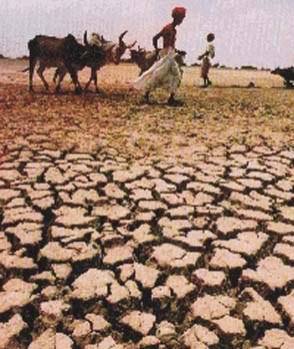 Transparency International in a report published Thursday blamed corruption in Bangladesh's water sector partly on politicians.
"Influential persons with political links with the help of engineers and other officials get involved in corruption in irrigation, river dredging and flood prevention projects," the TI said in its Global Corruption Report 2008: Corruption in the Water Sector.
Encroachment on lakes and rivers flowing through urban areas, especially in Dhaka, was common, it said. Transparency International in a report published Thursday blamed corruption in Bangladesh's water sector partly on politicians.
"Influential persons with political links with the help of engineers and other officials get involved in corruption in irrigation, river dredging and flood prevention projects," the TI said in its Global Corruption Report 2008: Corruption in the Water Sector.
Encroachment on lakes and rivers flowing through urban areas, especially in Dhaka, was common, it said.
"Officials in Rajuk often allegedly collude with land grabbers, which is the main reason for the failure to demarcate, develop and conserve water bodies crucial for Dhaka's environment, water supply and drainage."
The report was simultaneously launched in Dhaka, Berlin and London.
The TI report said fighting corruption in the water sector was urgent to deal with climate change and increasing stress on water supply around the world.
Nearly 1.2 billion people in the world do not have guaranteed access to water and more than 2.6 billion are without adequate sanitation.
In developing countries, about 80 percent of health problems can be linked back to inadequate water and sanitation.
At the report launch ceremony in CIRDAP auditorium in Dhaka, Professor Muzaffer Ahmad, chairman of the TIB's board of trustees, said local government, public works, land, shipping, industry, agriculture and water resources ministries were involved in corruption relating to water.
Up to 50 percent of the money allocated for the water sector goes in systems losses, he said.
Ahmad said there were 1,300 rivers in the country, but only 107 rivers are available in dry season. "Rivers are dying due to mismanagement."
Bangladesh has 54 cross-border rivers, but there is only one river agreement on Padma waters.
Ahmad said the government policy over the cross-border rivers was not clear. He suggested an agreement be signed with India, Nepal, Bhutan and China over river management.
TI Global Corruption Report 2008 argues that the crisis of water is a crisis of water governance, with corruption as one of the root causes.
According to the report, the need to adapt to climate change made the water sector more vulnerable to corruption.
"In developing countries, corruption is estimated to raise prices for connecting a household to a water network by as much as 30 percent. This inflates the overall costs for achieving the MDGs for water and sanitation by ore than $48 billion," the report said(Independent, June 28, 2008).
|
Back to Content
2. Groundwater Resource of Bangladesh
Groundwater resource of Bangladesh is identified by three aquifers :
- Upper aquifer or composite aquifer
- Main aquifer (it is at depths 6m in north-west and to 83 m in the South)
- Deep aquifer.
The main aquifer is separated from deep aquifer by clay layers of varied thickness. In most areas, the main aquifer is hydraulically connected with the overlying composite aquifer. Arsenic contaminated groundwater have been mainly detected in the upper and main aquifer, and possibly deep aquifer is also contaminated in areas where it is hydraulically connected with the overlying main aquifer. As the river flows in the downward gradient, ground water also moves relatively slowly if it is not closed by unpermeable layers.
Most of the upper ground water of Bangladesh has almost the same flow direction as the rivers. At high stream stage during monsoon, there may be direct recharge into the upper aquifer if it is not saturated with rain-water. At low-stream (dry-season) stage, there is a discharge from the aquifer into the stream. There is also possible that contaminated ground water from upper catchment source also moving in downward gradient.
The groundwater gradient and rate of groundwater flow are controlled by the distance between rivers and the balance between recharge and evaporation. This varies seasonally. In Bangladesh, hydraulic gradients are very low because of the limited relief The distribution, nature and size of present-day rivers also has an important effect on groundwater velocities and as such, rivers may play a significant role in controlling the short-range variability of groundwater arsenic concentrations through their effect on local hydraulic gradients.
Particularly low groundwater velocities are found in areas surrounded on two or three sides by a river, as for example in the inside of meanders. This may account, in part at least, for localised arsenic-rich 'hot spots' especially where the river system is stable for a long period of time.
Isolated high nitrate concentrations were occasionally found in the shallow groundwaters and are indicative of pollution (e.g. from latrines) and are likely to be accompanied by high concentrations of sulphate, chloride, bromide and often nitrite as well as bacteriological contamination. Like nitrate, concentrations of nitrite in the Special Study Areas were also mostly low, and usually less than the WHO guideline value of 0.91 mg l -1 as NO2-N. 4% of sampled wells had concentrations in excess of the guideline value. These were mainly but not always in samples which were thought to be polluted (BGS, Final Report, 2000).
The country faces water scarcity in the dry season due to decline in flow from upstream reaches, encroachment of wetlands and siltation of natural water bodies.
The findings came out in the final report on 'Water availability and usage regime in rural Bangladesh' commissioned under sustainable environmental management programme of ministry of environment and forest and UNDP (2003).
The report, prepared by DPHE and IUCN, said people's access to safe drinking water still falls critically short of the World Health Organisation (WHO) standards. There is a serious shortage of irrigation and drinking water in many parts of the country during the dry months from December to March, it pointed out.
Moreover, human activities such as use of agro-chemical and dumping of industrial and municipal wastes in the open water bodies have seriously deteriorated the surface water quality, the report said (The Daily Star, 18. 02. 03).
2.1 Dhaka City: decline of the groundwater
Being one of the largest mega cities of the world, Dhaka is facing continuing potable water -related problems over the last few decades. About 10 million people representing about 30% of the total urban population live in this capital city of the country. The population of the city is rapidly increasing each day since this city is the center of all sorts of financial, business, medical, educational and political facilities and services. The disproportionate rise in the urban population has created severe pressure on existing infrastructure and services, including water supply, sanitation, sewerage and drainage services. The environmental conditions in most part of the city are poor, with direct discharges of human and industrial wastes into river systems, possible contamination of groundwater from lack of adequate sewerage systems, direct industrial disposals and inadequate management of solid waste disposal.
On the other hand, due to increasing population and industrial growth the demand for fresh drinking water is rising rapidly. In Dhaka city, Water and Sewerage Authorities (WASA) are responsible for municipal water supplies. Presently, Dhaka WASA is producing 1160.21 Ml/day for the urban water supply from about 389 deep tube wells (DTW). About 84.33% of the municipal water supply for the domestic use comes mostly from the groundwater of the city. In addition, over 500 private tube wells of different depths also exist in this city, which are estimated to supply about 300 Ml/day, mainly to commercial and industrial users.
Available records and some groundwater related researches show that the groundwater abstraction in the city has increased by several hundred percent in last few decades. In 1980 about 112 million cubic meters groundwater was withdrawn from about 80 tube wells to meet the ongoing demands of the city. But the need for groundwaters increased so high that in 1990 about 136 tube wells were used to withdraw about 183 million cubic meters of groundwater. Presently, about 389 tube wells are producing about 1160.21 Ml/day of groundwater which can be projected to about 423 million cubic meters for the running year. Groundwater currently provides about 97% of Dhaka’s water demand.
Hydroeology
The metropolises are mainly located in the central part of the Dhaka district, which is occupied by the Pleistocene terraces mostly composed of the Madhupur clay deposits. The rest of the area is covered by the floodplains of the Jamuna, Padma, and Meghan rivers. There are some differences in the surface elevation of the city. The thickness of the Madhupur clay ranges from 8 m to about 45 m with an average thickness of 10 m in this city. The underlying layer is geologically known as the ‘Dupi Tila’, which composed of sand particles is also considered as the main aquifer of Dhaka city.
This sandy layer is overlain by the impermeable clay layer of variable thickness makes the groundwater aquifer mostly confined in nature. The total thickness of the Dupi Tila aquifer varies from 100 m to about 200 m with an average thickness of 140 m. Some scientific studies on the groundwater of the city revealed that the aquifer piezometric level, which is the natural water level of a confined aquifer of the city main aquifer has gone down significantly in last few years due to over withdrawal of groundwater from this groundwater system.
In many parts of the city the condition of the main aquifer has been changed from confined to an unconfined condition. Such change in the hydrodynamic condition can make the aquifer vulnerable to possible groundwater contamination, and also impede groundwater supply by tube wells.
Many research projects have ultimately ended up with the finding that the groundwater table of Dhaka city is dropping at a very high rate with time as indicated by long term hydrographs.
The city’s groundwater level has dropped about 20 meters over the last six years or more than 3 meters in a year on an average, according to a government survey. It is recoded that the drop in water level drastically increased in the late 80’s.
Data also suggested that in 1990 the depth to the water table in the peri-urban areas was about 4 meters and in the central region it was about 15 meters. However, in 2002, the water level in the city center (Motijheel area) was about 50 meters below mean sea level. WASA personnel also reported that their groundwater studies has revealed that the water table is declining two to three meters every year in Dhaka city and the intensity is high in and around the Motijheel commercial area. Such water level condition allows groundwater to flow towards the depressed city center from the peripheral areas.
Causes of decline of groundwater level
Various reasons are responsible for continuous groundwater drop in this city of which high groundwater withdrawal from the aquifer is the most crucial one. In addition, rapid urbanization including construction of roads, buildings, and other engineering structures, flood protection dams and embankments is continuously hindering the natural groundwater recharges from rainfall and perennial water sources existing in and around the city.
Disappearances of many lakes, canals, and small rivers in and around the city also depreciated groundwater recharge. Reports say that a network of 22 canals that facilitated the natural drainage for the floodwaters and groundwater recharge in this city has disappeared or shrunk over the last four decades. All these anthropogenic activities gradually obstructed the natural groundwater recharge, conversely deteriorated the water table condition over the last few decades
Lomming Danger
There is also concern about declining groundwater quality because the primary sources of recharge are the rivers, which are becoming increasingly polluted and narrower to provide more waterways. The quality of water in local rivers is also becoming a major cause of concern for suitability of use as a water source.
The water flow toward the city center may contain water pollutants from the adjoining rivers as part of natural aquifer recharge from surface waters. Subsidence - another possible environmental calamity may hit the city mainly in the central parts because of water table dropping that dries out the aquifer sediments, and help compaction of clay particles and hence cause land subsidence. For instance, lands in the Bangkok city of Thailand subsided for about 13 cm due to drop of the water table by several tens of meters in few decades. In addition, Dhaka city is located within a very high risk zone for high magnitude earthquake that may also facilitate high-scale regional land subsidence and loss of numerous lives and properties once a medium to high magnitude earthquake hits the city coupled with lowering down of city water table (M. Shamsudduha and M. Abdul Hoque
Holiday, October 10, 2004).
Hydrocarbon contamination in the groundwater of Dhaka city: a contemporary environmental concern
Bangladesh is suffering from one of the world’s worst cases of groundwater contamination by dissolved arsenic. Whilst about 35 million people of the country are drinking high arsenic groundwater, Dhaka, the capital of Bangladesh, is apparently free of arsenic contamination. However, the groundwater of this city is facing some continuing problems over the last few decades.
About 10 million people representing about 30% of the total urban population of the country live in this mega city are also putting extra stress on the groundwater resources everyday. Moreover, this disproportionate rise in the urban population is also creating severe pressure on existing infrastructure and services, including water supply, sanitation, sewerage and drainage services.
The environmental conditions in most part of the city are poor, with direct discharges of human and industrial wastes into river systems, possible contamination of groundwater from lack of adequate sewerage systems, direct industrial disposals and inadequate management of solid waste disposal. Amongst the occasional groundwater contaminants, hydrocarbons are the deadly contaminants that are assumed to have already occurred in the groundwater of Dhaka city or most likely happen in the near future.
Groundwater can be contaminated by the occurrences of hydrocarbon materials which, in most cases, are introduced by urban activities. When any hydrocarbon material like gasoline, oil or industrial solvents is found in groundwater of a substantial amount, the water is said to be contaminated. In general, the term ‘contaminant’ is used to refer to dissolved constituents or nonaqueous phase liquids (NAPLs). Contamination by NAPLs raises the level of complexity because contaminants can migrate as a separate liquid phase, a dissolved phase, and a vapor phase in the subsurface environments. Petroleum hydrocarbons and derivatives are made up of carbon and hydrogen that are primarily derived from crude oils, natural gas, and coal.
Depending on the nature and density the NAPLs are classified into two different categories: LNAPLs and DNAPLs. It is now necessary to define these terms. Simply saying, LNAPLs are the light nonaqueous phase liquids, which have densities less than water, and DNAPLs are dense nonaqueous phase liquids, are denser than water.
How they occur in the subsurface groundwater environments?
The process is very often complicated. Consider a spill of NAPLs on the ground surface or very close to water table in the subsurface. With time, these hydrocarbon products will percolate downward through the near surface unsaturated zone toward the water table, which is case of Dhaka city occurs from about several meters to tens of meters in some places. The most important process involves with this phenomena is the gravitational force that helps those NAPLs to flow toward the aquifers.
The lighter NAPLs if once reach the groundwater table they float onto the water table, whilst, the denser NAPLs on the other hand continue moving downward until they reach any impermeable layers, for instance, clay layer below the aquifer. Downward movement of DNAPLs displaces water because they have a specific gravity much greater than that of water.
Generally, these denser NAPLs flow towards the regional groundwater flow.
In such case, any potential groundwater contamination by hydrocarbons may contaminate groundwater in the central portion of Dhaka city as it is evident that the groundwater in this city moves towards the city center, where high groundwater abstraction of the city lowers down the water table to about several tens of meters over the years. However, the shallow water table areas are also vulnerable for such hydrocarbon related contaminations.
What are the commonly found NAPLs in the environment?
Like many other pollutant and contaminants the hydrocarbons are widely used in the urban areas of Dhaka city. Car fuels, such as, octane, petrol, diesel are the common hydrocarbons, are considered as the principal sources of LNAPLs in the urban areas. However, kerosene, crude oils, home heating oils, motor oils are also commonly used light hydrocarbons. Halogenated/non halogenated semi-volatiles and volatiles are the denser hydrocarbons, are typically found with chemical solvents, wood preserving wastes, coal tars, pesticides and many other industrial wastes.
In Dhaka city, the petrol stations, motor vehicle repairing shops, major hydrocarbon depots, bitumen industries, numerous chemical industries including pharma-ceuticals, and other hydro-carbon storage tanks are the main sources of NAPLs. Many fuel stations were developed in this city without proper hydrogeological investigations. Many of these stations are fairly old and are not maintained properly. The fuels are stored in a tank generally made up of iron, and therefore, very susceptible to external damage and leakages. The tanks are generally placed on a concrete structure without any proper sealing underneath the tank, which likely help spread out of fuel as soon as the hydrocarbon escapes from the storage tanks (M. Shamsudduha
, Holiday, November 11, 2004).
Dhaka perilously close to environmental disaster
One of the most populous mega cities of the world, Dhaka with a long history dating to pre-Moghul period, stands today perilously close to an environmental disaster with concentration of Nitrogen Dioxide, Sulphur Dioxide and Suspended Particulate Matters ( SPM ) much above the permissible limit.
This dismal picture of the city emerged at the Consultative Workshop on "Dhaka City State of Environment Report 2003," jointly organised by the Department of Environment and the Bangladesh Centre for Advanced Studies at LGED auditorium here yesterday. roundwater table in the capital dropped to 46.24 metres below the surface marking a steep fall of 20 metres in six years till 2003 as the water level in the rivers around it are declining fast.
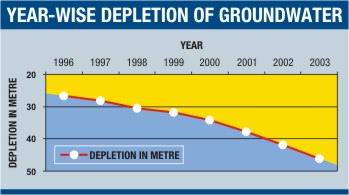 Water level of the Buriganga, the lifeline of the capital city, has gone down to 6.65 metres this year while the normal level was 7.23 metres in 1998 and 7.68 metres in 1988. Water level of the Turag has dropped to 7.29 metres, Tongi khal 7.01 metres and Balu river 6.98 metres this year.
As an increasing number of city people cannot use surface water from rivers, canals, lakes and other water bodies due to the fall in water level and consequent pollution, the pressure on groundwater has increased resulting in the decline of water table.
These were revealed at the 'Consultation Workshop on Dhaka City State of Environment Report-2003' jointly organised by the Department of Environment (DoE) and Bangladesh Centre for Advanced Studies (BCAS). Water level of the Buriganga, the lifeline of the capital city, has gone down to 6.65 metres this year while the normal level was 7.23 metres in 1998 and 7.68 metres in 1988. Water level of the Turag has dropped to 7.29 metres, Tongi khal 7.01 metres and Balu river 6.98 metres this year.
As an increasing number of city people cannot use surface water from rivers, canals, lakes and other water bodies due to the fall in water level and consequent pollution, the pressure on groundwater has increased resulting in the decline of water table.
These were revealed at the 'Consultation Workshop on Dhaka City State of Environment Report-2003' jointly organised by the Department of Environment (DoE) and Bangladesh Centre for Advanced Studies (BCAS).
The report showed that between December 2 and December 31, 2002, groundwater table fell by 0.34 metre or about one foot. It was 46.24 metres below the surface in 2003. The water table in Dhaka was on an average 42 metres below the surface in 2002, 37.78 metres in 2001, 34.18 metres in 2000, 31.86 metres in 1999, 30.45 metres in 1998 and 28.15 metres in 1997 and 26.6 metres in 1996.
The report pointed out that population of the capital is increasing fast and the water table is declining. The demand for water in the capital, the fifth largest city in the world with a population of over 12 million, is now 2,000 million litres per day (mld) as against 1,345 mld in 1998.
Experts said withdrawal of groundwater by deep tubewells is a major reason for fall in the groundwater table. In 1998, the number of deep tubewells was 234 but now the number is 381.
The number of deep tubewells is actually much higher as the owners of almost all the highrise buildings have installed them, a top official of Dhaka Water and Sewerage Authority (Wasa) said seeking not be named.
The environment report said concentration of heavy metals including cadmium, lead, mercury, chromium and aluminium in rivers around Dhaka is increasing day by day. Improper application of pesticides and disposal of industrial wastes are adding to the pollution.
To make things worse still, the city dwellers have to bear with the emission of about two million tons of carbon particles every year. The presence of such high level of harmful particles in the air has resulted in doubling the incidence of respiratory diseases among the city dwellers in the last five years, the report said.
The report says that concentration of heavy metal such as aluminium, lead, mercury and coli-forms in the waters of rivers and diminishing lakes of the city is threatening public health.
There is however some silver lining in the otherwise ominously cloudy picture. The air quality has improved somewhat in recent times thanks to government’s policy and intervention.
The report says that the increasing number of vehicles and their improper management and operation are responsible for degrading the air quality on one hand and creating noise pollution on the other. The quality of soil is also under threat due to mismanagement in terms of application of pesticides and disposal of industrial wastes, such as, waste of tannery, textile, dyeing and washing plants.
Water level of the Buriganga, the river that flows south of the city has gone down to 6.65 metre in 2004 than its normal
level which was 7.23 metre in 1998 and 7.68 metre in 1988.
Accordingly, water levels of Turag, Tongi Khal and Balu have also dropped to 7.29, 7.01 and 6.98 metres respectively in the same
year.
As the Dhaka Water and Sewerage Authority (Wasa) digs deeper into the ground in search of extractable water, as part of a new high depth tubewell initiative, the consequences for the environment and the public are becoming more and more grave, a WASA official and an expert warned.
Dr ANH Akhter Hossain, Managing Director of Wasa, said a total of 10 tubewells of a 1,000-foot depth have already been installed recently in the city's Mirpur area, with 35 more to be installed in the near future.
Wasa authorities have been compelled to undertake such an initiative because the existing 1,500 wells, whose depth reaches only 600 feet, can no longer extract water due to a serious depletion of the underground water level, he pointed out.
Other Wasa officials have asserted, however, that Wasa will not be able to keep the number of 1,000-foot tubewells under 45, and may continue to increase the number by an indefinite amount in the future.
The move has caused concern both within and outside of Wasa, with officials of the water authorities as well as experts saying it could have a destructive impact on the environmental conditions of the city.
Professor Nazrul Islam of the Department of Geography and Environment at Dhaka University, says Wasa should avoid ground water extraction and search for surface water sources in order to save the groundwater environment. "Presently, only 25 percent of the water is collected from surface water sources, but this should be significantly increased on a priority basis," he said.
Relying on groundwater extraction alone poses a grave threat to land subsidence, with a potentially negative impact like that experienced in countries like Bangkok and Mexico, he said. "Two decades ago land subsidence of a few inches took place every year [in those countries] due to unbridled groundwater extraction."
While the benefits remain uncertain, the results to the environment could be seriously harmful, he explained.
"The initiative to set up 1000-feet depth tubewells in the city is very destructive since existing 600-feet deep tubewells have already created a large vacuum within the underground level due to a lack of water recharge, making the situation very vulnerable to earthquakes," he asserted.
He went on to say that increasing the number of high depth tubewells in the city may be an immediate solution to the water crisis, but that it will boomerang in the long term for the city dwellers, causing natural disasters.
"Finding no other alternative, Wasa authorities have undertaken the initiative as a short time solution due to the government's failure to assemble funds to increase surface water sources," he asserted.
A high official and expert within Wasa, who spoke on the condition of anonymity, cautioned that Wasa should have conducted a study to determine whether city dwellers will actually benefit from the installation of the 1000-feet deep tubewells.
The report identified as many as 20 reasons including population growth, lack of coordination between government
agencies, brick kiln, unplanned urbanisation, improper traffic and transport management , lack of awareness and finally lack of
transparency and accountability on the part of different types of organisation dealing pollution and degradation of environment in
360 sq. km city corporation areas ( Daily Stat, The Independent, December 24, 2004).
|
Water supply crunch
Going deeper underground could spell disaster
The WASA, in its bid to collect ground water, seems set to install a large number of tubewells with a depth of 1000 feet in the city. The existing 600 feet deep tubewells are not considered adequate to extract water due to a significant lowering of the ground water table.
The experts have said in very clear terms that excessive dependence on ground water can invite environmental hazards of various kinds. Experience shows that over-extraction of ground water can cause land subsidence and lead to creation of underground vacuums which make us all the more vulnerable to earthquake. Ground water is not being recharged at the same rate as it is depleted. In effect, the process of digging deeper and deeper will have to be continued endlessly. Clearly, the tubewell-based water supply has already been stretched to its limits.
The answer to the problem lies in having surface water treatment plants and going for conservation of rainwater for lean-time use. Only the first phase of the Sayedabad water treatment plant, which was conceived donkey years back, has been completed. Fund constraints are said to be the biggest inhibiting factor as far as completion of the second and third phases of the plant is concerned. But the question is when funds are available for so many other projects, why the same could not be arranged for an undertaking of such importance as the Sayedabad water plant? However, the silver-lining around the cloud is the prospect for Danida and Sida finances to complete the projects. The job is cut out for the government to try and expedite the process of fund-raising.
WASA's policy is dangerously short-sighted. Ironically, it is the outcome of successive governments' failure to adopt a long term water extraction policy based on surface sources, but given the dreadful consequences of going deeper with tubewells we must abandon the course.
A time-bound plan to harness surface water that can obviate further tapping of ground water has to be adopted sooner than later (Editorial, Daily Star, March 8, 2005).
Water Crisis - total shortfall is now 500 million litres per day
The government is going to formulate a master plan with ADB assistance for adequate availability of potable water in the city, the supply of which is at least 25 per cent less than the demand at present. The total shortfall is now 500 million litres per day and is likely to be three times more by 2015 if the trend is not rolled back.
So, the need for better management of water resources and improving upon the existing collection and distribution systems can hardly be over-emphasised. Already, the situation is critical as too much extraction of ground water has resulted in an alarming lowering of the subsoil water table. The side effects of the underground water level can be disastrous. Land subsidence, the signs of which have been noticed in some places around the city in recent times, is one of the hazards that unplanned extraction of ground water could invite. And the risk of earthquake damage being multiplied is also there. So the bulk of water requirements should come from surface water. And better planning is needed to avoid any crisis during the lean periods. That's why emphasis should be laid on use of rainwater and its conservation for the dry season.
The weaknesses in the management of Water and Sewerage Authority must also be eliminated to avoid wastage of water. A huge number of consumers in the city slums are still dependent on illegal connections for water supply. Things have to be set right there because no planning will be effective as long as such unaccounted for consumption continues. Water supply to the slums has to be ensured, but not in an unlawful manner. Moreover, WASA has a weak distribution system with leakage that allows entry of pollutants, causing both contamination and loss of water.
The task of maintaining water supply consistent with demand in the years to come will be a daunting one, given the gap between the installed capacity and the ever increasing demand. The formulators of the master plan should concentrate on both capacity building through surface water plants and combating the environmental fallout of excessive ground water extraction over time (Daily Star, August 9, 2005).
The Parched City Waits- April 2009
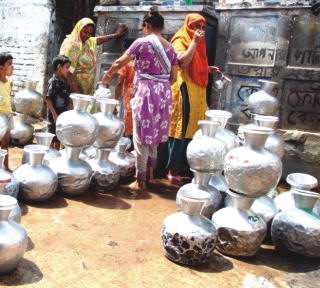 |
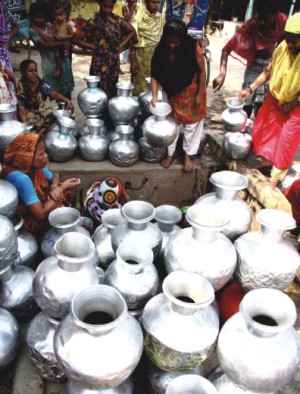 |
Instead of developing a master plan, Dhaka Water Supply and Sewerage Authority (Wasa), has always taken the short cut approach of installing deep-water pumps to meet the immediate crisis. Such initiatives have been proved ineffective. Thus during every dry season from (March to June) Dhaka City dwellers suffer from an acute water crisis. In many parts of the city people get sticky and straw coloured water from the Wasa supply line.In other parts they don't get a drop for days.
The government, however, has a history of touting the most impractical plant such as for the last few decades it had plans to supply water to the city dwellers through augmenting water from the Padma River, a plan that has never been implemented. Instead of developing a master plan, Dhaka Water Supply and Sewerage Authority (Wasa), under the Ministry of LGRD, has always taken the short cut approach of installing deep-water pumps to meet the immediate crisis. Such initiatives have been proved ineffective.
Thus during every dry season from (March to June) Dhaka City dwellers suffer from an acute water crisis. In many parts of the city people get sticky and straw coloured water from the Wasa supply line. Such contaminated water, which causes many water-born diseases, is a public health disaster.
History
The first water supply system was introduced in Dhaka by the British in 1888 under the jurisdiction of the district civil surgeon at Chandighat. The Chandnighat plant treating water from the Buriganga River has the capacity of supplying 3.9 crore litres of treated water to supply mainly in the localities under Lalbagh Police Station and Kotwali Police Station. However, after so many years the treatment plant is unable to produce according to its normal capacity. Moreover, the source of water for the plant, the Buriganga River, has become biologically dead because of ongoing water pollution caused by industrial and domestic sources. The conventional treatment plant, which uses only lime and chlorine for treatment, cannot neutralise the existing pollutants in river water, many of which may cause serious health hazards. That is why people get sticky straw-coloured water in the areas where water from the Chandnighat is supplied.
The first deep-water pump was installed in Dhaka in 1949. Till the end of 1960s the water supply in Dhaka was almost surface-water system based. Dhaka Wasa was formed in 1963, being separated from the Department of Public Health Engineering (DPHE), with the aim of giving better service to its city dwellers. It inherited only 33 deep pumps from DPHE. But, to meet the ever increasing demand of the city dwellers of one of the fastest growing mega-cities in the world, Dhaka Wasa without having any long-term vision, kept on installing deep-water pumps on a crisis by crisis basis.
The dependence on groundwater for domestic, industrial, and commercial water supply in the city area was more than 95 per cent prior to the commissioning of a surface water treatment plant (Sayedabad Surface Water Treatment Plant) in 2002.
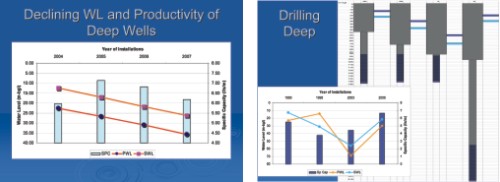
Excessive use of underground water (180 crore litres a day) through deep tube wells without any adequate replenishing mechanism has lead to an alarming drop in the underground water level. People living in the areas such as Mirpur, Shyamoli, Gulshan and Dhanmodi are going through the same water crisis as most of the existing pumps in these areas cannot abstract water properly from the ever-decreasing underground water layer, especially in the dry season when the water level naturally decreases further.
The ground water layer in the city, in fact, is dropping by around three metres a year on an average. But without considering this, Wasa has been abstracting water from the underground, which is causing the water in the aquifer layer to disappear altogether. Each year, the rate of pumping water from underground through deep-water pumps is increasing at a frightening rate of 15 per cent.
According to hydrogeologists, this not only exacerbates the already sever water crisis but will in the future, cause land to subside. Already most of the available water of the upper aquifer layer has been used up. Now Wasa is installing deep aquifer pumps to abstract water from the second layer. But even this is becoming difficult in many areas of Dhanmondi, Mirpur, Niketan, Nakhalpara, Ibrahimpur and Manipur.
Annual rainfall is over 2,000 mm in Bangladesh which can be used to recharge the underground water through dug wells, ponds and abandoned wells of Wasa. The low-lying areas near Dhaka can be used as surface water reservoirs using the water of the monsoon. It will help recharging and at the same time can be used for surface water source."
(E. Kamol, Daily Star, april 24, 2009)
Study finds Hazaribagh water most contaminated
Pollution gets to groundwater
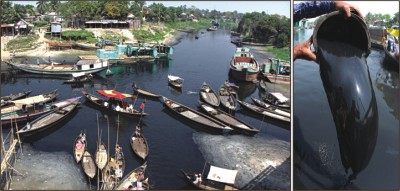 |
The photo on the left taken from Trimohani Bridge shows the jet-black waters of the Balu. Rampant dumping of sewage, industrial waste and garbage has turned the water into a thick liquid, right picture, which spread stench in the area. Environmentalists' and civil society's repeated demand to solve the problem produced little result and the Department of Environment seems to have given up hope as it does not measure the water's pollution level anymore.
|
River pollution around the capital has reached such a level that the groundwater system where the aquifers are recharged from the riverbeds is being contaminated, a recent study shows.
In the seven months from November to April, virtually no water but only stinky mucky liquid flows in the gradually narrowing rivers -- the Buriganga, Shitalakshya, Turag and Balu -- as no governments could stop discharge of liquid waste into them.
A recent study jointly done by the World Bank and the Institute of Water Modelling (IWM) says: "The groundwater system is being contaminated in areas where aquifers are recharged from the riverbeds. The pollution is creeping towards the central part of the city with time."
The study mentions groundwater in Hazaribagh, home of toxic tannery industries, as the most affected. "It is quite likely that in the long run groundwater would be affected from the surface at solid waste or industrial effluent dumping ground," the report adds.
Currently, 85 percent of the total demand of city water is met through groundwater sources as most of the surface water is contaminated, according to Dhaka Water and Sewerage Authority (Wasa).
The IWM survey shows there are over 300 various effluent discharge outlets in Dhaka city and Narayanganj. Of these, 19 outlets carry major discharge of mixed effluents of industrial and household waste which is falling into the rivers around the capital.
Movements by environmentalists as well as demands by the civil society could not change the situation. Now the situation is so worse that no living organism survives in the stinky thick black liquid of the Buriganga, Shitalakshya, Balu and Turag.
The foul odour of the polluted black water strikes the nostril even at half a kilometre distance. The pollution has become so 'usual' that the Department of Environment now does not measure its level anymore.
The overall situation suggests that the city dwellers have no immediate respite from it.
During a recent visit to the Buriganga, Shitalakshya, Balu and Turag rivers this correspondent could not stay for long on the banks.
At the Sadarghat and Mitford Hospital points many passengers were seen crossing the river on boats covering their nose.
"It stinks round the clock. We are habituated with this but are really having hard times due to the mosquitoes," boatman Bazlu Mia said.
At the Kanchpur Bridge point of the Shitalakshya, Trimohini point of the Balu and Tongi point of the Turag the waters are so stinky and polluted that hardy any fish or other aquatic life form could survive there.
People living by the rivers say just twenty years ago these rivers abounded with different varieties of fish.
"We used to see Gangetic dolphin in the Buriganga near Millbarrack point even in the end of the 80s," says Shakhawat Hossain, a resident in Shyampur.
But in just two decades indiscriminate discharge of human excreta, household garbage and industrial waste, mainly liquid waste of dyeing and tannery industries, left the rivers dead.
The Wasa treats the polluted black water of the Shitalakshya and Buriganga and supplies stinky water to the city dwellers by 'purifying' it with chlorine and ammonia sulphate.
Now the pollution has set in on the rivers Buriganga and Shitalakshya and made it almost impossible to treat their waters.
All Dhaka rivers left 'dead'
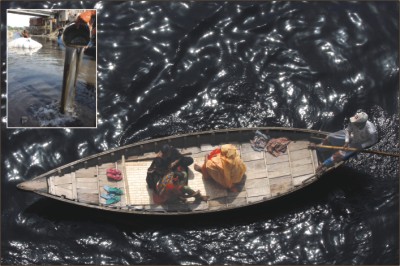 A boat carries passengers, top, on the murky waters of the Buriganga. Wholesale dumping of industrial waste, sewage and garbage left the river, touted the lifeline of the capital, in this sorry state. The photo was taken from Bangladesh-China Friendship Bridge-2. Inset, the photo taken at Lalbagh shows the filthy water of the Buriganga.
A boat carries passengers, top, on the murky waters of the Buriganga. Wholesale dumping of industrial waste, sewage and garbage left the river, touted the lifeline of the capital, in this sorry state. The photo was taken from Bangladesh-China Friendship Bridge-2. Inset, the photo taken at Lalbagh shows the filthy water of the Buriganga.
According to a study jointly conducted by the World Bank and the Institute of Water Modelling (IWM), there are over 300 various effluent discharge outlets from nine major industrial clusters including Tongi, Hazaribagh, Tejgaon, Tarabo, Narayanganj, Savar, Ashulia, Gazipur and Ghorashal.
Of these, 19 outlets carry the major discharge of domestic and industrial waste.
Of the discharged untreated liquid waste, 61 percent are industrial and 39 percent domestic waste, the study shows. The lone Sewerage Treatment Plant (SWP) in Pagla in Narayanganj can treat only 10 percent of the industrial waste.
The primary estimates made in this study show that nearly 330,000 kilograms of BOD is discharged from various polluting sources every day in Dhaka watershed.
"This gives an indication of the extensive pollution loads from various domestic and industrial sources. The situation is extremely precarious particularly during the six months of the year from November to April," the report states.
Over the last 10 years major industrialisation in the Dhaka watershed has been observed, especially in dyeing, washing and textiles sectors. It is estimated that there are over 7,000 industries in Dhaka metropolis located mostly in three clusters -- Hazaribagh, Tejgaon and DND area.
According to statistics from DoE, the number of polluting dyeing mills is 365, tanneries 198, pharmaceutical units 149, engineering workshops 129, chemicals and pesticide factories 118, jute mills 92, rubber and plastic units 63, food and sugar 38, paper and pulp 10, cement and fertilisers five each and distilleries four.
However, the real number is much higher than the statistics, and among all these the dyeing factories and tanneries are the main polluters of the rivers.
Asked why the industries don't use ETPs even if they have it, a DoE chemist explains the reason. He says, "If a dyeing factory produces one tonne of cloth, it discharges 100 cubic metres of liquid waste equivalent to 100,000 litres of water.
"A factory needs to spend Tk 300 to Tk 400 to purify one cubic metre of water excluding electricity and manpower costs.
"They just don't want to spend that money," the DoE chemist says.
Waste from these industries is connected to the sewerage system that directly leads to the rivers around the city. In fact, the rivers have become a dumping ground of all kinds of solid, liquid and chemical waste of bank-side population.
According to the Environment Conservation Rule, 1997, every industry should have an in-house ETP. Otherwise, they would not get from DoE the environmental clearance, which is mandatory to obtain power and gas connections.
Mahmud Hossain, owner of a washing plant in Gazipur, said their industry generated 150 cubic metres of waste water every day.
"We need to spend Tk 8-10 lakh per month for lime, poly electro lime, polly aluminium chloride and polly electro chloride to treat the waste," Mahmud added.
"If we are honest we can treat the wastewater before discharging and even make profit from the business," he commented (P. Roy,Daily Star, 27. 04. 09)
BUET RESEARCH ON RIVER POLLUTION
A recent research by Bangladesh University of Engineering and Technology (Buet) shows the pollution level in the Buriganga, Shitalakshya, Balu and most parts of the Turag so high that simply no living organism can survive in their waters.
A three-year research finds that some invertebrates and small organisms come to life in these rivers when water flow increases in the rains. But these life forms completely disappear in the dry season, the researchers add.
The researchers have found the Turag, Balu, Buriganga and Shitalakkhya to be the most affected rivers.
They say the waters in these rivers are affected by industrial effluents and wastewater. The waters are also affected by municipal sewage disposal contamination, agro-chemicals and large amount of suspended sediments carried by upstream flow.
The oxygen level of the Buriganga, Tongi canal of Turag and a part of Norai is less than one in per microgram. All species of local fish need 4-6 level of oxygen in per microgram to survive, says the study conducted by the Buet water resources department.
During water quality assessment using bio-indicators method, the researchers collected samples thrice from the Chadnighat point of the Buriganga but twice failed to get any life form.
Bio-indicators respond to the quality deterioration from multiple and varied pollution sources and thus provide an overall picture of water quality.
"In this method we collect sediments from the riverbed and test the environmental health of the river by counting available aquatic creatures in those. The creatures in the sediments vary on the basis of pollution level," says one of the researchers.
The researchers collected samples and tested those in pre-monsoon and post-monsoon seasons.
In the post-monsoon season oxygen level increases slightly but not enough, the researchers observe.
They found that oxygen levels were 0.7 and 0.25 in Chadnighat point, 0.27 and 0.63 in the Norai near Trimohini, and 0.27 and 0.63 in the Turag in Tongi before and after the monsoon respectively (P. Roy, Daily Star 26, 04. 09).
Groundwater level drops 3 metres a year; collapse in surface feared
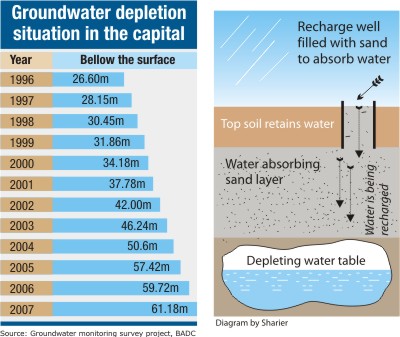 Groundwater table in the capital has dropped down to 61.18 metres below the surface, 35 metres in the last eleven years, due to lack of recharging which has put the sprawling metropolis at great risk.
In 1996 the groundwater table was only 26.6 metres bellow the surface. But it went 61.18 metres below in 2007, declining at the rate of over three metres on average every year.
Experts say as an increasing number of city people cannot use surface water due to consequent pollution, pressures on groundwater have increased, resulting in declination of water table.
Groundwater table in the capital has dropped down to 61.18 metres below the surface, 35 metres in the last eleven years, due to lack of recharging which has put the sprawling metropolis at great risk.
In 1996 the groundwater table was only 26.6 metres bellow the surface. But it went 61.18 metres below in 2007, declining at the rate of over three metres on average every year.
Experts say as an increasing number of city people cannot use surface water due to consequent pollution, pressures on groundwater have increased, resulting in declination of water table.
"If water table continues to fall then a vacuum will be created in the aquifer which could cause a sudden collapse in the surface," said Khandakar Fazal Hasan, chief geologist of Bangladesh Agricultural Development Corporation (BADC).
"In Bangkok city it happened due to over extraction of groundwater," he warned.
A study undertaken by BADC recently has pointed this sharp drop in groundwater level in Dhaka city.
According to the study, Dhaka's groundwater level was 59.72 metres below in 2006, 57.42 metres in 2005, 50.6 metres in 2004, and 46.24 metres in 2003.
The water table in Dhaka was on average 42 metres below the surface in 2002, 37.78 metres in 2001, 34.18 metres in 2000, 31.86 metres in 1999, 30.45 metres in 1998, 28.15 metres in 1997 and 26.6 metres in 1996.
The study was carried out with a vertical automatic water level recorder, which is now the most accepted method of verifying water level.
Quoting a Wasa report, officials said underground water table was on average 11.3 metres below the surface in the 1970s and 20 metres in the 1980s.
The experts say the decline is occurring fast side by side with the increase of population. Demand for water in the capital, fifth largest city in the world with a population of over 12 million, is now more than 2,000 million litres per day (mld) which was 1,500 mld in 1998, Wasa sources said.
The three water treatment plants provide with uneven amounts -- Sayedabad supplies 225 million litres, Chadnighat 39 million litres and Narayanganj 46 million litres. The remaining has to be extracted from groundwater sources.
The experts say withdrawal of groundwater by deep tube-wells is a major reason for fall in the table. In 1998, the number of deep tube-wells was 234, which now stands over 400.
The number is actually much higher as the owners of almost all the high-rises have installed deep tube-wells, a top official of Wasa (Dhaka Water and Sewerage Authority) said seeking not be named.
Sources say Wasa's two treatment plants can meet only 20 percent of the city's demand by treating the surface water. The rest is met by deep tube-wells.
Based on their statistics, Wasa officials say water level has drastically fallen since 1996 in almost all parts of the city including Mirpur, Dhaka Cantonment, Dhanmondi, Mohammadpur and Old Dhaka.
Department of Environment sources say concentration of heavy metal including cadmium, lead, mercury, chromium and aluminium in rivers around Dhaka is increasing day by day. Improper application of pesticides and disposal of industrial waste are also adding to the pollution.
Pollution has already made the surface water of Dhanmondi, Gulshan-Baridhara and Ramna lakes unusable.
"Declining groundwater level will greatly increase the risks during earthquakes. It could lead to subsidence of the clay soil plate Dhaka is situated on," said Khandakar Fazal Hasan.
Asked about possible remedial actions, he said wetlands and water bodies should be preserved to recharge the groundwater level.
"It's not possible for us to decrease withdrawal of groundwater as treating surface water in full volume is not possible due to contamination. So we should go for groundwater recharging," he noted.
Over the years, different real estate businesses have encroached on open space, lakes and rivers, barring full recharging of groundwater in the monsoons (P. Roy, Daily Star, March 26, 2008).
Underground reservoirs can be recharged
The underground water table of Dhaka can be recharged easily during the rainy season by artificially infiltrating water through the topsoil layer of ground into the sub-soil reservoirs, local geologists said.
Hydrologists in many countries experiencing rapid depletion of underground water table apply artificial methods to keep their water table healthy and prevent subsiding of the ground.
In Germany, coal mine companies practise a cheap, simple yet intelligent method to recharge their sub-soil water reservoirs depleted because of mining.
According to the German hydrologists, water is pumped back to the underground reservoir using simple infiltration wells and ditches.
The topsoil of the land that grows trees retains water. As a result rainwater cannot recharge a depleting sub-soil water level. The topsoil also retains water from the rivers and ponds.
Beneath this level of soil is the sand and silt zone which easily absorbs water and send it to the water reservoir beneath.
The German infiltration wells designed by leading mining company RWE are dug like a traditional well through this topsoil, which may be typically 20-30 feet deep. Once the well hits the sand zone, it fills up the well with sand. When water is poured using pumps, the sand absorbs it instantly and sends it to the sub-soil water reservoir.
Such a well can pump in millions of cubic metres of water every year.
This method can also greatly help recharge Dhaka's water tables fast during the rainy season.
According to Dhaka Water Supply and Sewerage Authority (Wasa), the city of 10 million people consumes 75,000 litre water per second using a total of 2,500 deep tube wells of which Wasa owns 800-1,000.
The present highest sub-soil water level of Dhaka lies at a depth of 210 feet, which used to be less than 50 feet two decades ago.
The Bangladeshi topsoil--called Madhupur Clay Layer--is 10-45 feet deep. Beneath it lies the sand and silt zone called Dupi Pila.
Infiltration wells can be dug at a very low cost and these could greatly speed up the water recharging system (Daily Star, March 25, 2008).
Living with dirty, stinky Wasa water in Dhaka
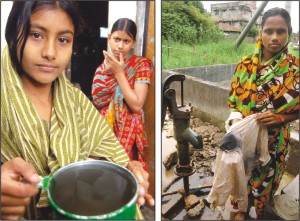 Many inhabitants of the eastern part of Dhaka are getting contaminated water from the Wasa supply line that poses a threat of serious health hazards for lakhs of people.
The residents of Rampura, Ulan, Goran, Sipahibagh, Basabo, Madartek and Nandipara areas complain that the Wasa water they get is blackish and stinky.
FM Nazmul Haque, a resident of Madartek, said, “Wasa water is not usable at all. For the last couple of months we have been buying water jar and bottled water for drinking, which has increased our living cost. For other purposes we collect water from neighbouring places. The situation has deteriorated as soon as the Ramadan began.”
Many inhabitants of the eastern part of Dhaka are getting contaminated water from the Wasa supply line that poses a threat of serious health hazards for lakhs of people.
The residents of Rampura, Ulan, Goran, Sipahibagh, Basabo, Madartek and Nandipara areas complain that the Wasa water they get is blackish and stinky.
FM Nazmul Haque, a resident of Madartek, said, “Wasa water is not usable at all. For the last couple of months we have been buying water jar and bottled water for drinking, which has increased our living cost. For other purposes we collect water from neighbouring places. The situation has deteriorated as soon as the Ramadan began.”
RJM Rabiul Kaiser, Wasa executive engineer of MODS Zone-6, said he has been getting complaints from several areas and taking immediate actions to resolve the problem.
Explaining the reasons behind the contamination of water, Kaiser pointed out that dirty reserve tanks of the individual subscribers, illegal leakage in pipelines done by the locals and lack of pressure in the Wasa pipeline might have caused the problem.
Kaiser further said that after getting complaints from the subscribers they have examined the samples of underground reserve tanks and in most cases they have found that the water of the supply line is quite normal but the water at the reserve tank is contaminated.
“The reason is the subscribers do not clean their reserve tanks regularly,” he said.
However, in an application to the executive engineer of MODS Zone-6, Dhaka Wasa, people from some mohallas of Madartek said after the recent flood each and every resident of the area has cleaned their underground reserve tanks as per the instruction of Wasa, but they still get contaminated water from the supply line.
Kaiser said whenever Wasa finds any problem in the supply line, immediate actions are taken for repairing the leakages. During the Ramadan Wasa is supplying water in small containers at mosques and bazaars at the time of Sehri and Iftar.
On the Madartek issue Kaiser said, “I personally visited the area. We have repaired many leakages in the supply lines, which is not an easy process as we do not have modern equipment to find out the exact spot of such leakages.”
“But, the major problems that I found in the areas are lack of pressure in the pipelines and open drains on roads. Filthy water from these drains can easily mix with the pipeline water through the leakages,” the Wasa engineer said.
About the possible solution to the problem, he said a new pump will be installed on the Madartek Government Primary School premises to increase the pressure in the supply line. “We are ready to set up a new pump, but influential locals are not allowing us.”
Asked about the matter, Headmistress of the school Hasina Aktar said school authorities have no problem to set up a pump for the welfare of the people of the area. She suggested that Wasa can set up the pump at three decimals land of her 12-decimal school compound that are at present illegally possessed by influential locals.
Local Ward Commissioner (No 27) Golam Hossain also said he would try his best to demolish the illegal structures on the school premises as soon as Wasa sends the new pump at the place.
On the other hand, Wasa Executive Engineer Kaiser said that first the place must be freed from illegal occupancy, unless Wasa cannot send any pump. “We will need more than Tk 60,000 for carrying the total pump set to the spot. Who will bear the carrying cost if they fail to evacuate the place after sending the pump?” (E. Komol, Daily Star, september 26, 2007).
Water crisis deepens at infectious
diseases hospital
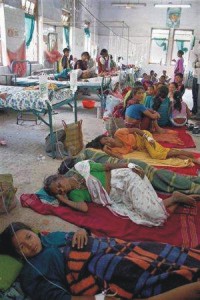 Water crisis has become acute at infectious disease hospital in Mohakhali, causing immense sufferings to both the patients and hospital staffs.
Water crisis has become acute at infectious disease hospital in Mohakhali, causing immense sufferings to both the patients and hospital staffs.
Senior consultant Dr Syed Zahir Uddin Ahmed said shortage of water has been causing severe sufferings to the patients and staffs.
‘We have requested the Public Works Department and WASA authorities several times to deal with the problem, but they took no heed of it,’ said Dr Ahmed who is also the director of the hospital.
The director said they were paying bills regularly but failed to get water as per demand.
A doctor at HIV ward said, ‘Infectious patients undergoing treatment at the hospital are prone to be attacked by other infectious diseases due to unhygienic environment caused by water shortages.’
The hospital authorities said they were getting one-fourth of water, claiming that unsanitary conditions caused by shortages of water make the hospital vulnerable to spread the infectious diseases through air.
Emergency medical officer Sirajul Islam said on average fifty infectious patients are admitted to the hospital every day. Besides, some 200 patients visit the doctors at outpatient department of the hospital, he added.
The bathrooms, toilets and washing basins of the seven-storey hospital are found with unclean clothes, stinky stale food, water bottles and glasses while the piles of garbage at every nook and corner are common phenomenon.
Some patients said their sufferings knew no bounds as they hardly got water to bathe, wash clothes or utensils regularly. They claimed they even didn’t get water for using toilet or bathing for days.
A number of staffs of the 100-bed hospital said they couldn’t do regular services due to acute water crisis for a couple of months.
An attendant of a jaundice patient said, ‘I even don’t know where I will get drinking water tomorrow for my son who has been suffering from jaundice for a week as I don’t afford to buy drinking water.’
Some 200 family members living at the staff quarters were also facing severe crisis of water.
They said a number of slum dwellers surrounding the hospital took unauthorised water connections from the hospital’s main line, depriving the patients and staffs of getting water.
The hospital authorities asked the PWD and WASA to stop such illegal supply but they didn’t respond to it, some employees claimed.
A WASA official said that zonal office could deal with the problem. ‘If there is water crisis, the hospital authorities should go to zonal office in Mohakhali and they will take steps to resolve it.’
Contaminated water
 We the city dwellers in capital Dhaka and Narayanganj solely depend on Wasa for our water. There is no other source of water in these places. Wasa is a government owned water supply agency, a semi-autonomous body under the administrative control of the LGRD ministry. Wasa is supposed to supply pure water suitable for human consumption. But it has miserably failed to perform its task of supplying safe water. Recently, the city dwellers have been observing with concern that Wasa is supplying water, which is muddy and smelly. This has been going on for a pretty long time. In the 21st century it may sound incredible, but it is the reality in Bangladesh.
We the city dwellers in capital Dhaka and Narayanganj solely depend on Wasa for our water. There is no other source of water in these places. Wasa is a government owned water supply agency, a semi-autonomous body under the administrative control of the LGRD ministry. Wasa is supposed to supply pure water suitable for human consumption. But it has miserably failed to perform its task of supplying safe water. Recently, the city dwellers have been observing with concern that Wasa is supplying water, which is muddy and smelly. This has been going on for a pretty long time. In the 21st century it may sound incredible, but it is the reality in Bangladesh.
The Wasa high-ups and the ministry concerned should take immediate and pragmatic measures to supply pure water to its twelve million customers (Tahamid Ashraf, Bashabo, Dhaka
, aily Star, April 4, 2008).
Floodwater and tubewells
It is reported that most of our tubewells in the flood affected areas have gone under water and there is an acute shortage of drinking water.
Over fifty thousand people of our country are now reported to be suffering from the water borne disease diarrhoea.
Government have failed to supply and protect drinking water knowing fully flood and other disaster.
Our Ministry of Health is issuing and publishing advertisements in newspapers and also making announcements over radio and television as to how to procure drinking water from the tubewells gone under floodwater by fixing an extra tube/pipe on the mouth of the tube well above the level of floodwater for supply of drinking water.
Has the Ministry of Health supplied any extra pipe/tube to the flood affected people or made any public demonstration as to how to fix an extra pipe/tube on the mouth of the tubewell for supply of drinking water?
If you ask Health Ministry, they say it is the duty of disaster nangement ministry, and when you ask disaster mangement ministry, it is the duty of LGRD Ministry or Public Health.
Millions Money Landed to Unknown Places
If the government thinks that corruption has been conquered than it is stupid to believe it. Billions of dollar has been spent to ensure safe water. But where is the safe water?
Now the World Bank has approved a US$ 102.26 million credit to support Bangladesh's efforts in improving its national water resource management (September 20, 2007).
The Bank has approved again the loan in Washington DC on Tuesday with an expectation that some 2 million households would benefit from the project, according to a message received here yesterday:
The Water Management Improvement Project is designed to enhance water management by expanding the role of local communities, from planning and design to operations and management.
It also aims to improve institutional performance of the country's principal water institutions - Bangladesh Water Development Board (BWDB) and Water Resources Planning Organisation (WARPO).
Bangladesh is prone to recurring natural disasters like floods, erosion, cyclones and tidal surges that result in human casualties and economic losses.
The project will support rehabilitation and improvement of about 102 existing flood control, drainage, and irrigation schemes and transfer their management to the local communities through Water Management Organisations (WMOs).
It will also support measures to improve performance of another 98 existing schemes that do not require major rehabilitation and have functioning WMOs or similar organisations.
“The long-term objective of the project is to institutionalise a participatory management process for improving the performance of all feasible water schemes,” said Masood Ahmad, World Bank's lead water resources specialist and project team leader.
Participation of all stakeholders, especially local communities, from the outset is crucial in order to promote sustainability and to ensure the long-term integration of social and environmental considerations,” he said.
We do not know where the money will reach. This is not the corruption but our experts are the "his master voice" of the foreign experts! The projects are not according requirements of the rural population. Their advice are not noted.
2. 2. Underground water level falling alarmingly in northern districts
The underground water level in 8 districts of northern districts of the country including Dinajpur is falling gradually posing a threat to Irri-Boro farming. About 30 per cent tubewells in the area have become inoperative for want of water in the underground level.
The farmers are resinking their shallow tubwells by digging soil from two or five meters depth in some areas of the region to reach the underground water level to irrigate their paddy fields.
A source said that the water reserve in the upper part of underground water level has been exhausted and the next level has gone down by 10 to 15 feet. It is feared that water level will fall further if there is no sufficient rainfall.
The badly affected districts are Dinajpur, Thakurgaon, Kurigram, Rangpur, Lalmonirhat, Nilphamari and Gaibandha. The water reserve in those districts is shrinking and the lifting of water become impossible by thousands of shallow tubewells, low lift pumps, traditional pumps and deep tubewells. The small rivers, beels, haors and ponds are drying up.
According to a NGO consultancy firm the northern region including the Barendra region has the possibility of turning into desert if the water lifted from underground level exceeding 15000 cusecs a year. But at present about one lakh cusecs of water are being lifted for irrigation which is alarmingly higher than the red signal.
Most alarming is that the lifted water are not being proportionately compensated by regular seasonal rainfall. The maximum gaps may cause natural disaster at any time if the situation continues as cautioned by the experts.
The underground water level in the rural areas of 10 upazilas of the district has fallen at an alarming rate causing scarcity of drinking water and affecting the irrigation in the irri-boro fields.
The production target of irri-boro cultivation may not be achieved. This year in the district for want of water as the ground water level has fallen and almost all the water bodies including rivers, canals and ponds dried up affecting irrigation seriously.
The soaring prices of diesel including other necessary agricultural inputs, erratic power supply, and use of adulterated and substandard fertilizer will affect irri-boro production.
The farmers in most areas specially in rural and haor areas of the district now fall it extreme difficult, to lift ground water by shallow tubewells (STW) and deep tubewells to irrigate their irri-boro crops land as the underground water level has fallen abnormally in the district.
A large number of shallow and deep tubells have gone out of operation in the district due to sharp fall in the underground water level threatening irri-boro cultivation.
Tubewells inoperative
Some 500 shallow and deep tubewells out of 15000 and more than 1000 tara pumps out of 1500 remained inoperative in the district bor want of sufficient underground water.
The official sources informed The Bangladesh Observer that underground water level in the town and suburban areas has fallen by 15 to 20 feet.
Water bodies dry up
Besides, almost all water bodies including rivers, canals, ponds and beels have dried up in the district affecting irrigation in the crop fields.
An expert of the department of Hydrology said that everything has been undergoing changes with the change of season.
He also said that the indiscriminate setting up of deep and shallow tubewells and the pump houses is also responsible for the fall in the underground water level in the district.
At least 5000 irrigation pumps are now engaged in lifting water for irrigation purposes in the district. The cumulative pressure on the ground water for irrigation hampered this year.
The people of the district are facing acute shortage of drinking water due to adverse affect of unplanned water lifting.
If the present month passes without rainfall the drought like situation will persist in the district and may affect production of irri-boro crops this year.
The farmers of the district have been affected by early flood during irri-boro season last year (The Bangladesh Observer, March 22, 2005).
2. 3. Groundwater depletion all over the country March 2008
Groundwater-based irrigation system is experiencing difficulties in different parts of the country as shallow aquifer level is getting out of reach due to fast depletion of groundwater table.
Shallow tube-wells (STWs) now cannot draw water for about 46 percent irrigated cropland during dry season thanks to current level of groundwater declination, says data from Survey and Monitoring of Groundwater project and groundwater zoning map.
STWs can draw groundwater for irrigation within a depth of 2-7 metres.
"The problem persists mainly in the dry season when farmers irrigate their cropland," said Khondakar Fazle Hasan, chief geologist of Bangladesh Agriculture Development Corporation (BADC).
Asked how farmers do the irrigation if STWs don't work, he said they make a pit five to six feet bellow the surface and put the shallow pump there to draw groundwater.
According to 2006-07 irrigation survey report of the government, around 10 million farmers have overwhelming dependence on STWs for almost 70 percent of 47.8 lakh hectares of irrigated cropland in the last Rabi season.
The groundwater zoning map of BADC prepared in 2006 shows that a record high of 78 percent irrigated cropland in Pabna has become critical for STW operation.
The level is 75 percent in Comilla, 60 percent in Kustia and Naogaon, 55 percent in Mymensingh and Cox's Bazar, 50 percent in Joypurhat, 49 percent in Chittagong, 45 percent in Bogra and Rajbari and 30 percent in Jhenidah, Netrakona, Gazipur and Narayanganj.
In 62 upazilas, the groundwater level goes down more than seven metres. In 14 of these upazilas from the country's central and northern parts, water level goes over 11 metres down in dry season, says the quarterly monitoring report of Survey and Monitoring Project for Development of Minor Irrigation.
Besides, farmers are being unable to draw water by STWs for 28 percent of the land in Sherpur, 20 percent in Jamalpur and Tangail, 18 percent in Natore, 16 percent in Manikganj, 15 percent in Dhaka, Narsingdi and Sirajganj, and 10 percent in Rajshahi, Chapainawabganj, Kishoreganj and Munsiganj.
Experts say regulation of water flow in the Ganges at Farakka point by India has caused a reduction of dry season flow. Decreased flow in the Padma and its distributaries has affected the pump irrigation, they add (Daily Star, March 9, 2008).
Ground water drops 11m in 40 years
Experts at a workshop held in Tangail on Saturday disclosed that due to over use and wastage, ground water level has fallen by 11 metres during the last 40 years, causing threat to our environment. They also said that instead of the required 2700 litres of water, farmers in the country are using 4000-4500 litres of water to produce one kg of rice. This information was disclosed at a workshop organised in Tangail at the Deputy Commissioner’s conference room to mark the World Water Day 2014. District administration, Public Health Engineering and NGO Forum for Public Health Tangail zone arranged the workshop. The workshop was presided over by Deputy Director of Local government Department Goutam Chandra Paul.
The key note paper at the workshop was presented by Executive Director of SIRAD Dr. Monir Uddin. The panelists told that water has a close connection with agriculture in Bangladesh. About 33,680 deep tube wells and 15,49,149 shallow tube wells are currently in operation in the country. Water for agriculture and house hold need is being collected from surface water as well as ground water. Due to over-use and wastage, water level has dropped 11 metres during the last 40 years, they said.
The speakers said arsenic pollution is not a major threat in Tangail. But pollution in surface water in the district is alarming. Elements like Iron, manganese and fluoride, which are present 10 mg in one litre, is five times higher than the tolerable limit and poses considerable health hazard for the people.
Civil surgeon of Tangail Dr. Sayed Ibne Sayeed, addl deputy commissioner Abu Saleh Mohammad Mohi Uddin Khan, BWDB Executive Engineer Farook Bhuyan, Information Officer Kazi Golam Ahad, BRAC official Munir Hossain, BELA official Goutom Chandra, Executive Director of Dhew, Jebunnesa Mahmud, among others, spoke on the occasion. The welcome address was made by NGO Forum for Public Health Tangail zonal manager Md. Mosarraf Hossain (The Independent, 25 March 2014) .
WARN OF A GREAT HIMALAYAN QUAKE
GREEN REVOLUTION
Back to Content
3. Asia Faces Water Catastrophe
Tube wells are sucking groundwater reserves dry, driving Asian countries towards environmental catastrophe, New Scientist says.
Tens of millions of these wells have been drilled over the past decade, many of them beyond any official control, and powerful electric pumps are being used to haul up the water at a rate that far outstrips replenishment by rainfall, the British weekly says in next Saturday's issue.
The extraction is providing many countries with a lavish harvest in thirsty crops like rice, sugar cane and alfalfa, but the boom is bound to be short-lived, it says.
Indeed, water tables are falling so dramatically that within a short time, some landscapes could become arid or even be transformed into desert, it says, quoting scientists at a worldwide water conference.
In the case of India, smallholder farmers have driven 21 million tube wells into their fields and the number is increasing by a million wells per year.
"Nobody knows where the tube wells are or who owns them. There is no way anyone can control what happens to them," Tushaar Shah, head of the International Water Management Institute's groundwater station, based in Gujarat, said.
"When the balloon bursts, untold anarchy will be the lot of rural India."
Half of the country's traditional hand-dug wells have already run dry, as have millions of shallower tube wells, causing some despairing farmers to commit suicide, he said.
In China's north plain, that country's breadbasket, 30 cubic kilometers (1.059 trillion cubic feet) more water are being extracted each year by farmers than are being replaced by the rain, New Scientist said.
Groundwater is used to produce 40 percent of the country's grain.
In June, the state paper China Daily admitted that the nation "may be plunged into a water crisis" by 2030 when its population is scheduled to peak at 1.6 billion.
The tube-well revolution, whose technology is adapted from the oil industry, has also swept water-stressed countries like Pakistan and Vietnam, where precious underground reserves are likewise being depleted, New Scientist says.
"Vietnam has quadrupled its number of tube wells in the past decade to one million, and water tables are plunging in the Pakistani state of Punjab, which produces 90 percent of the country's food."
The scientists spoke at the Stockholm Water Symposium, a conference held in the Swedish capital last week (SIWI, August 28, 2004)
|
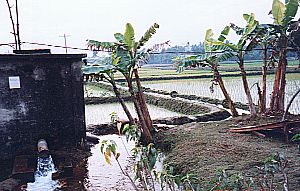
Charles Harvey of the Massachusetts Institute of Technology suggests that water pumping for agricultural irrigation may be influencing the release of arsenic into drinking water.
Harvey and his colleagues argue that irrigation pumping draws down the levels of underground aquifers, which are then replenished by monsoon rains and other surface waters. As these surface waters percolate through the rich soil of farmlands, they carry organic carbon into the upper levels of the aquifers, where it reacts with arsenic bearing rock to release arsenic into the water.
The "Science" article suggests that drilling wells into the deeper, older waters of ancient aquifers could avoid much of this newly released arsenic and provide safer drinking water.
(Environment News Service, November 25, 2002).
But unfortunately C. Harvey forgets that arsenic in sediments of Bangladesh is normal to all other sediments, arsenic contaminated fertilizer is found in Fertilizers . New and deep ground water (irrigation water) contaminated with arsenic
The general conclusions from the sediment studies are that the sediments are typical of alluvial and deltaic
sediments with normal amounts of arsenic, mainly in the 1-10 mg kg -1 range for total arsenic (BGS; Final Report, 2000)
Back to Content
4. Hydrogeology of Bangladesh
The surface water plays a vital role to the quality of ground water.The combined flow of the Ganges and Brahmaputra typically vary between less than 5000 m 3 /s in the
driest period (March-April) to 80,000-140,000 m 3 /s in late August to early September (WARPO, 2000).
The contribution of local rainfall to the annual surface
runoff is about 25 per cent, with significant seasonal variation. Annual rainfall and evapotranspiration of the country show that there is a substantial excess of rainfall everywhere in the monsoon season. From the annual overall averages, dependable rainfall exceeds evapotranspiration by over 10 per cent in most parts of the country, except in the Northwest (NW) and Southwest (SW) regions. In the NW region, rainfall and evapotranspiration are almost equal, but in the SW the overall deficit is about 10 per cent. From November to May, evapotranspiration exceeds rainfall all over the country, except in the Northeast (NE) region (WARPO, 1999).
In terms of quality, the surface water of the country is unprotected from untreated industrial effluents and municipal wastewater, runoff pollution from chemical fertilizers and pesticides, and
oil and lube spillage in the coastal area from the operation of sea and river ports.
Recent alluvium forms prolific shallow aquifers under water table or leaky conditions and, beneath the uplifted Barind and Madhupur blocks, the Plio-Pleistocene Dupi Tila Formation forms an important leaky-to- confined aquifer. Both are used for irrigation and water supply. The transmissivity of the alluvial aquifers is typically in the range of 1 000 to 5 000 m 2 /d, and is highest beneath the alluvial floodplains. The distribution of aquifer and water properties has been strongly influenced by the pattern of river incision and infilling that occurred in response to glacial-eustatic sea level changes in the Quaternary (Ravenscroft 2001).
The characteristically brown Madhupur Clay and Dupi Tila sands are the remnants of uplifted blocks that existed during sea-level low stands. Monsur (1995) deduced an early Pleistocene age for the Madhupur Clay, while Whitney et al. (1999) infer ages of 25,000 and more than 125,000 years for the surfaces of the Barind and Madhupur Tracts respectively.
The valley-fill sediments are represented by the Dhamrai and Chandina Formations. Deposits of the terminal Pleistocene-Holocene transgression reach a thickness of at least 90 m in the central Jamuna valley (JICA, 1976). However, dating of wood samples by BGS (1992)points to the presence of stepped terraces (probably Middle or Upper Pleistocene) between the central valley and the Madhupur Tract.
Sediments
Sediments of the major interfluves (or doabs as defined by Singh et al. 1999) are brown, oxidised and highly weathered with a surface clay cover. As aquifers, they are generally confined, having low vertical and horizontal permeability and specific yields, but they contain water of excellent quality; it is typically a sodium bicarbonate type, with EC between 200 and 500 µS cm -1 , low iron (less than 1 mg l -1 ), and with arsenic
concentrations mostly less than 10 µg l -1 .
The Holocene sediments are typically grey, unweathered, and
often contain abundant organic matter. Although the Holocene aquifers have high permeability (40 -80 m d -1 ), specific yield and potential recharge rates, they have poorer water quality, the water being fresh but more mineralized (EC 500 - 1 200 µS cm -1 ) and contain higher proportions of calcium and magnesium. The waters are anoxic, high in iron, manganese and bicarbonate but mostly low in nitrate and sulfate; many are sulfidic and/or methanogenic (Ahmed et al. 1998; Nickson et al. 1998, 2000; DPHE 1999; Gavrieli et
al. 2000).
The piezometric surface is within a few metres of the surface for most of the year. In areas of intensive irrigation, water levels fall to between 5 and 15 metres below ground for two to three months but return to the ground surface in low lying areas during the monsoon, when the aquifer is full.
Only in Dhaka City, in response to intensive and continuously increasing abstraction, has the water table been permanently lowered and an original confined condition has become unconfined. Outside Dhaka City, gross annual
abstraction ranges from a few tens of millimeters a year where groundwater is used only for drinking to over 500 mm a year in areas of intensive tubewell irrigation.
About 2.5 million out of the 10 million dwellers of mega-city Dhaka are suffering from problems with pure drinking water, causing deaths to over 10,000 children every year due to water-borne diseases, a seminar was told on Monday.
The seminar on World Summit on Sustainable Development "(WSSD) Fair 2002: Perspective Bangladesh" is organised by the Ministry of Environment and Forest and the United Nations system in Dhaka, commemorating the Earth Summit in Johannesburg.
Ground water Flow
The groundwater gradient and rate of groundwater flow are controlled by the distance between rivers and the balance between recharge and evaporation. This varies seasonally. In Bangladesh, hydraulic gradients are very low because of the limited relief. Hand-pump tubewells are unlikely to have a major effect on groundwater flow. Irrigation wells with their larger volumes of abstraction will tend
to draw water from groundwater rather than from river recharge and may thereby change the local hydraulic gradients significantly. However, groundwater movement and hence aquifer flushing, is inherently very slow in Bangladesh.
Under typical groundwater gradients, the timescale to replace the groundwater within an aquifer is of the
order of tens of thousands of years. Modelling of the Faridpur aquifer indicated that percentages of flow to the deep aquifer (taken to be greater than 130 m depth) can vary by as much as three times (4–12%) depending on the distribution of hydraulic properties of the sediment profile. Lithological information from the borehole log obtained for Faridpur suggests that, unlike elsewhere in Bangladesh, there is not an extensive, well-defined aquitard layer between the shallow and deep aquifer (BGS, DPHE, 2001).
Hand-pump tubewells are unlikely to have a major effect on groundwater flow. Irrigation wells with their larger volumes of abstraction will tend to draw water from groundwater rather than from river recharge and may thereby change the local hydraulic gradients significantly
The distribution, nature and size of present-day rivers also has an important effect on groundwater velocities and as such, rivers may play a significant role in controlling the short-range variability of groundwater
arsenic concentrations through their effect on local hydraulic gradients.
Back to Content
5. Facies Change
Holocene geology of Bangladesh is very complex. River dominated deltaic sedimentation dominated by lateral migration with some minor channel. There is a hierachy of channels. The first order channels encompass the whole river and may comprise several second-order channels which, in turn, have third-order channels within within them. Bar types include lateral (point) bars, diagonal bars, medial bars asnd tributary bars. The pattern of deposition comprises mid-channel bars, channel abandonment, laterl accretion to bank and addition to bars (upstream acretion, flanl accretion and downstream accretion).
IDENTIFICATION OF FACIES CHANGE WITHIN
CONTAMINATED AREA AND LOCATE AND CONSTRUCT
ARSENIC FREE SHALLOW WELLS, CHEAPEST METHOD
There are wells that are highly contaminated but a few wells show ground water arsenic concentration is far below Bangladesh standard. Based on an understanding of the geological origins of contamination, it may be possible to identify areas or strata that are at relatively low risk of arsenic contamination. In some areas arsenic contamination is confined to highly localized sedimentary deposits
If these hot spots are identified through widespread arsenic testing, new wells can be preferentially installed in relatively safe areas. In areas where some geological units are arseniferous and others are not, it is important to avoid cross-contamination, which can occur in several ways. In some cases, the arsenic-rich zones may be naturally in hydraulic connection with arsenic-free zones.
By pumping water from arsenic-free zones, arsenic-rich water may be induced to flow into previously uncontaminated strata, and eventually may reach the well. In other cases, the arsenic-rich and arsenic-free zones may be separated by low-permeability materials such as clays. Drilling can disturb this natural barrier, and the borehole itself (specifically, the annular space around the well pipe) may provide a high-permeability conduit from one zone to another
It may sound puzzling but the aquifers are different. Local relief and rivers impact on the direction and velocity of groundwater flow and therefore on the migration of arsenic. Groundwater flow from high to low relief causes deeper penetration contaminants into the aquifer. The reverse is true in areas that are low in relief. Here upward groundwater movement would bring contaminants to shallower horizons.
At Khailpur most of the wells are arsenic contaminated but in some areas a few wells found to be arsenic free. At Kahailpur after 12 drilling arsenic free aquifer has been identified at depths 40-55 feet within channel sand facies.
At Alipur and Vashan Char, Ambikapur, Faridpur we have identified at 40-55 channel sand facies with arsenic free aquifers.
This method can be applied to other areas for easy and cheap access of arsenic free water. This needs careful formation evaluation and routine monitoring (Anwar, 2002)
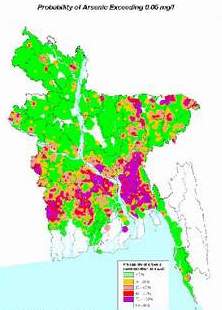
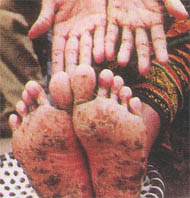

1. Educational Project
2. PROJECT REPORT 2003
3. Project Report 2004
Back to Content
6. Arsenic and Other toxic Metals
About 20-25 million people of the country are at risk of exposure to arsenic contamination, speakers said yesterday at the inaugural ceremony of an international conference. They also said there are more than 8,000 villages in the country which are at the risk of arsenic contamination.
Department of Public Health and Engineering (DPHE) and United Nations Children's Fund (Unicef) jointly organised the five-day conference at a city hotel where around 53 experts and government delegates from 12 Asian countries including Bangladesh are taking part. Sheikh Kurshed Alam, secretary of Local Government Division (LGD), inaugurated the conference.
Speaking as the chief guest Kurshed Alam said the country has long been suffering from arsenic problem. "We have to ensure safe water for all," he said adding that regional support is imperative to face the crisis.
Unicef Representative Carel de Rooy said around 60 million people in the world are at risk of exposure to high levels of arsenic contamination and more than 80 percent of these people live in Asia. Around two-third of this people live in two countries -- India and Bangladesh, he added
(The Daily Star, March 06, 2009 )
According to an ongoing study by the World Commission on Water for the 21st Century. While the rich benefit from subsidized treated piped water, water vendors charge the poor up to 100 times more for water of doubtful quality in some cities such as Port-au-Prince, Haiti and Nouakchot, Mauritania. We know from econometric analysis, that the poorest suffer the most from arsenicosis in Bangladesh (WHO, 2000). Most arsenic patient of Bangladesh is still drinking arsenic contaminated water and can hardly afford any medical treatment or piped water.
The poorest can barely afford to offer money or time for a village committee or maintenance of installations. Therefore, local communities allow each of the families that are making use of the water resource to contribute an amount they can afford. Sometimes, contribution from 30 families for a deep tubewell of Tk. 5000 varies between Tk. 0 and Tk. 800 or piped water. Relatively well-off people who can afford to contribute a large amount of money or to become a member of a village committee, are able to derive more privileges from their increased status.
Despite the quite impressive network of DPHE thana, district and division offices, these departments are hopelessly subject to inefficiency, bureaucracy, corruption, lack of capacity, lack of capabilities, lack of professionals etc.
The WB functions best in countries like ours because we have no performance audits, no accountability, extreme crony corruption and, to be honest, inadequate mental faculties to challenge them. Those who have chase them for assignments. And so everyone has a stake in the World Bank.. What became obvious was the extreme contempt in which the official technocrats and bureaucrats held ordinary people. The entire idea of development in Bangladesh is based on the GO-NGO co-operation model and the people have little role to play in this. NGOs are generically fund seekers and now provider of employment. Most of them have almost no reality beyond this. And this generally grovelling bunch conveniently represents the public face in the eyes of the donors who ultimately decide policies. Not because they want to but because they have to. The ability of the national counterparts is so low that they would not be able to formulate a policy without donor support. They are unable to disagree either because that might mean fund cuts. So it all ends up in the same basket (Afsan Chowdhury, 2002).
|
Arsenic can undergo eight electron reductions from the +5 to the -3 state and occurs in +5, +3, 0 and -3 states in aquatic systems. The variable chemical behaviour of arsenic is exemplified by its hard acid behaviour As+3 and soft base behaviour in compounds. It forms variety of inorganic and organic compounds of different toxicity to aquatic organisms. Under reducing conditions transfer As+5 to As+3. This is due to the varying physico-chemical properties of arsenicals in different valence states. pH or pE (electron free energy) conditions ultimately determines boundaries between solid and dissolved phases, for As(OH)3 / (As2 S3 ).
Arsenic contamination occurs mainly in the top aquifer (40 m) that is recharged from the surface. Arsenic concentration in ground water occurs in extreme
diverse nature but one thing is common - area surrounded by rice fields and the concentration correlates with phosphate., although soil of Bangladesh
very poor in phosphate,(The British Geological Survey and McMacdoland (UK) Ltd, 1999)
No name pesticides are widely used in Bangladesh. A high amount of arsenic, copper, chromium etc,. is found in surface water (Ratan, 2000). The principal
sources of ground water recharge in Bangladesh include:
- Rain water that infiltrates the surface and percolates through the unsaturated
zones;
- Flood waters from rivers and streams that overflow and percolate through unsaturated zone;
- Stream or canal flow where the surface water level is higher than the ground water level;
- Percolation from ponds, beels (wetlands), baors and other water bodies that are above the water table;
- Seepage from irrigation ditches and water from irrigated fields; and
- Lateral flow of ground water from adjacent areas with higher water levels;
- Lateral flow of ground water from adjacent areas with higher water levels.
It is almost impossible to purify a large contaminated ground water even in the highly technically developed resourceful industrial countries.
The recent transition in Bangladesh from drinking surface water to drinking tubewell water has significantly reduced deaths from water-borne pathogens; however, disease and death from As in groundwater is affecting large areas of the country. In addition, the finding of small children with melanosis and keratosis, which are typical symptoms of arsenic poisoning in adults, and the observation of an analytical interference for the measurement of iron raised the question of other metals magnifying the toxic effects of As (Sarkar, 1998; Frisbie, Maynard, and Hoque, 1999).
It reveals unsafe levels of Mn, Pb, Ni and Cr. Our survey also suggests that groundwater with unsafe levels of As, Mn, Pb, Ni and Cr may extend beyond Bangladesh’s border into the 4 adjacent and densely populated states in India. In addition to the health risks from individual toxins, possible multimetal synergistic and inhibitory effects are considered. Considering the population of this country and that 97% of its people drink from wells (UNICEF, 2002; WHO, 2000), these data suggest that tens of millions of Bangladeshis are drinking water with unsafe levels of As, Mn, B, Ba, Cr, Mo, Ni, Pb, or U
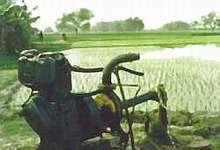
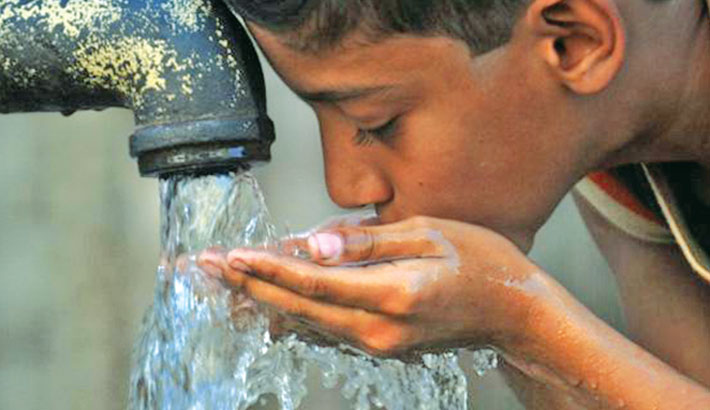
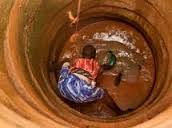 Driving down the underground water tables may cost high in the long run. This has been causing arsenic contamination that has already affected millions of people in the country. Arsenic contaminated water is extracted and used in irrigation which affects the fertility of soil as well.
Driving down the underground water tables may cost high in the long run. This has been causing arsenic contamination that has already affected millions of people in the country. Arsenic contaminated water is extracted and used in irrigation which affects the fertility of soil as well.
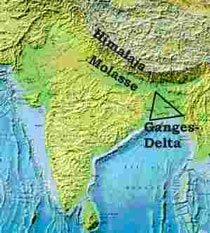 The Bengal Basin is a tectonically active subsiding depression formed at the junction of the Asian, Burmese and Indian plates, and is infilled with more than 15 km of marine and alluvial sediments of Cretaceous to Recent age. Throughout the Quaternary, the combined Ganges, Brahmaputra and Meghna (GBM) river system of Bangladesh has deposited a thick sequence of mixed alluvial and deltaic deposits in response to changes in sea-level rise and fall brought about by glacial cycles.
The Bengal Basin is a tectonically active subsiding depression formed at the junction of the Asian, Burmese and Indian plates, and is infilled with more than 15 km of marine and alluvial sediments of Cretaceous to Recent age. Throughout the Quaternary, the combined Ganges, Brahmaputra and Meghna (GBM) river system of Bangladesh has deposited a thick sequence of mixed alluvial and deltaic deposits in response to changes in sea-level rise and fall brought about by glacial cycles. Geneva: The largest mass poisoning of a population in history is now underway in Bangladesh.
It is a terrible public catastrophe, asserts Allan H. Smith, Professor of Epidemiology at the University of California, Berkeley, and a WHO consultant who has investigated arsenicosis in Bangladesh on several trips.
The number of people affected by this arsenic disaster is among the greatest of any disease facing the world today. "By virtue of its sheer size it is pushing the limits of our knowledge and capacity to respond to it," asserts Professor Hans van Ginkel, Rector of the United Nations University in Tokyo.
The crisis has, however, spurred intense research in water de-contamination techniques - how to ensure tens of millions of people arsenic-free drinking water when their water supply comes from wells, many of them rich in arsenic.
How many Bangladeshis are exposed to a high level of arsenic?
Geneva: The largest mass poisoning of a population in history is now underway in Bangladesh.
It is a terrible public catastrophe, asserts Allan H. Smith, Professor of Epidemiology at the University of California, Berkeley, and a WHO consultant who has investigated arsenicosis in Bangladesh on several trips.
The number of people affected by this arsenic disaster is among the greatest of any disease facing the world today. "By virtue of its sheer size it is pushing the limits of our knowledge and capacity to respond to it," asserts Professor Hans van Ginkel, Rector of the United Nations University in Tokyo.
The crisis has, however, spurred intense research in water de-contamination techniques - how to ensure tens of millions of people arsenic-free drinking water when their water supply comes from wells, many of them rich in arsenic.
How many Bangladeshis are exposed to a high level of arsenic?  At the beginning of this 21st century, the World Health Organisation estimated that of the world's six billion people, at least 1.1 billion lack access to safe drinking-water and 2.4 billion are living without access to sanitation systems. An estimated 14 to 30 thousand people, mostly young and elderly, die everyday from avoidable water-related diseases (e.g. diarrhoeal diseases). The lives of these people who are among the poorest on our planet are often devastated by this deprivation, which impedes the enjoyment of health and other human rights. Water is a limited natural resource and fundamental for life and health.
At the beginning of this 21st century, the World Health Organisation estimated that of the world's six billion people, at least 1.1 billion lack access to safe drinking-water and 2.4 billion are living without access to sanitation systems. An estimated 14 to 30 thousand people, mostly young and elderly, die everyday from avoidable water-related diseases (e.g. diarrhoeal diseases). The lives of these people who are among the poorest on our planet are often devastated by this deprivation, which impedes the enjoyment of health and other human rights. Water is a limited natural resource and fundamental for life and health. Transparency International in a report published Thursday blamed corruption in Bangladesh's water sector partly on politicians.
"Influential persons with political links with the help of engineers and other officials get involved in corruption in irrigation, river dredging and flood prevention projects," the TI said in its Global Corruption Report 2008: Corruption in the Water Sector.
Encroachment on lakes and rivers flowing through urban areas, especially in Dhaka, was common, it said.
Transparency International in a report published Thursday blamed corruption in Bangladesh's water sector partly on politicians.
"Influential persons with political links with the help of engineers and other officials get involved in corruption in irrigation, river dredging and flood prevention projects," the TI said in its Global Corruption Report 2008: Corruption in the Water Sector.
Encroachment on lakes and rivers flowing through urban areas, especially in Dhaka, was common, it said.
 Water level of the Buriganga, the lifeline of the capital city, has gone down to 6.65 metres this year while the normal level was 7.23 metres in 1998 and 7.68 metres in 1988. Water level of the Turag has dropped to 7.29 metres, Tongi khal 7.01 metres and Balu river 6.98 metres this year.
As an increasing number of city people cannot use surface water from rivers, canals, lakes and other water bodies due to the fall in water level and consequent pollution, the pressure on groundwater has increased resulting in the decline of water table.
These were revealed at the 'Consultation Workshop on Dhaka City State of Environment Report-2003' jointly organised by the Department of Environment (DoE) and Bangladesh Centre for Advanced Studies (BCAS).
Water level of the Buriganga, the lifeline of the capital city, has gone down to 6.65 metres this year while the normal level was 7.23 metres in 1998 and 7.68 metres in 1988. Water level of the Turag has dropped to 7.29 metres, Tongi khal 7.01 metres and Balu river 6.98 metres this year.
As an increasing number of city people cannot use surface water from rivers, canals, lakes and other water bodies due to the fall in water level and consequent pollution, the pressure on groundwater has increased resulting in the decline of water table.
These were revealed at the 'Consultation Workshop on Dhaka City State of Environment Report-2003' jointly organised by the Department of Environment (DoE) and Bangladesh Centre for Advanced Studies (BCAS).



 A boat carries passengers, top, on the murky waters of the Buriganga. Wholesale dumping of industrial waste, sewage and garbage left the river, touted the lifeline of the capital, in this sorry state. The photo was taken from Bangladesh-China Friendship Bridge-2. Inset, the photo taken at Lalbagh shows the filthy water of the Buriganga.
A boat carries passengers, top, on the murky waters of the Buriganga. Wholesale dumping of industrial waste, sewage and garbage left the river, touted the lifeline of the capital, in this sorry state. The photo was taken from Bangladesh-China Friendship Bridge-2. Inset, the photo taken at Lalbagh shows the filthy water of the Buriganga. Groundwater table in the capital has dropped down to 61.18 metres below the surface, 35 metres in the last eleven years, due to lack of recharging which has put the sprawling metropolis at great risk.
In 1996 the groundwater table was only 26.6 metres bellow the surface. But it went 61.18 metres below in 2007, declining at the rate of over three metres on average every year.
Experts say as an increasing number of city people cannot use surface water due to consequent pollution, pressures on groundwater have increased, resulting in declination of water table.
Groundwater table in the capital has dropped down to 61.18 metres below the surface, 35 metres in the last eleven years, due to lack of recharging which has put the sprawling metropolis at great risk.
In 1996 the groundwater table was only 26.6 metres bellow the surface. But it went 61.18 metres below in 2007, declining at the rate of over three metres on average every year.
Experts say as an increasing number of city people cannot use surface water due to consequent pollution, pressures on groundwater have increased, resulting in declination of water table.
 Many inhabitants of the eastern part of Dhaka are getting contaminated water from the Wasa supply line that poses a threat of serious health hazards for lakhs of people.
The residents of Rampura, Ulan, Goran, Sipahibagh, Basabo, Madartek and Nandipara areas complain that the Wasa water they get is blackish and stinky.
FM Nazmul Haque, a resident of Madartek, said, “Wasa water is not usable at all. For the last couple of months we have been buying water jar and bottled water for drinking, which has increased our living cost. For other purposes we collect water from neighbouring places. The situation has deteriorated as soon as the Ramadan began.”
Many inhabitants of the eastern part of Dhaka are getting contaminated water from the Wasa supply line that poses a threat of serious health hazards for lakhs of people.
The residents of Rampura, Ulan, Goran, Sipahibagh, Basabo, Madartek and Nandipara areas complain that the Wasa water they get is blackish and stinky.
FM Nazmul Haque, a resident of Madartek, said, “Wasa water is not usable at all. For the last couple of months we have been buying water jar and bottled water for drinking, which has increased our living cost. For other purposes we collect water from neighbouring places. The situation has deteriorated as soon as the Ramadan began.”
 Water crisis has become acute at infectious disease hospital in Mohakhali, causing immense sufferings to both the patients and hospital staffs.
Water crisis has become acute at infectious disease hospital in Mohakhali, causing immense sufferings to both the patients and hospital staffs.
 We the city dwellers in capital Dhaka and Narayanganj solely depend on Wasa for our water. There is no other source of water in these places. Wasa is a government owned water supply agency, a semi-autonomous body under the administrative control of the LGRD ministry. Wasa is supposed to supply pure water suitable for human consumption. But it has miserably failed to perform its task of supplying safe water. Recently, the city dwellers have been observing with concern that Wasa is supplying water, which is muddy and smelly. This has been going on for a pretty long time. In the 21st century it may sound incredible, but it is the reality in Bangladesh.
We the city dwellers in capital Dhaka and Narayanganj solely depend on Wasa for our water. There is no other source of water in these places. Wasa is a government owned water supply agency, a semi-autonomous body under the administrative control of the LGRD ministry. Wasa is supposed to supply pure water suitable for human consumption. But it has miserably failed to perform its task of supplying safe water. Recently, the city dwellers have been observing with concern that Wasa is supplying water, which is muddy and smelly. This has been going on for a pretty long time. In the 21st century it may sound incredible, but it is the reality in Bangladesh.
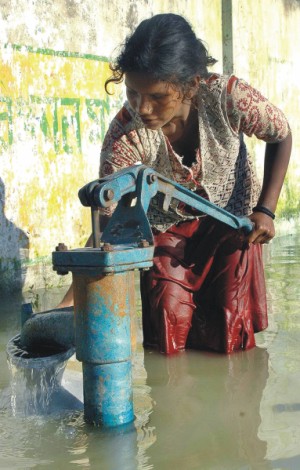
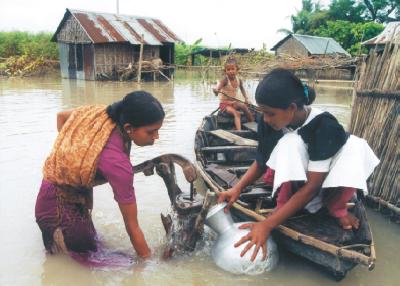




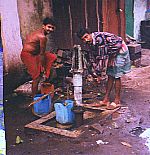 Arsenic based pesticides are produced in India. Chatterjee, A. and A. Mukherjee. Sci Total Environ 225(3): 249-62 (Hydrogeological investigation of ground water arsenic contamination in south Calcutta) reports:.
Arsenic based pesticides are produced in India. Chatterjee, A. and A. Mukherjee. Sci Total Environ 225(3): 249-62 (Hydrogeological investigation of ground water arsenic contamination in south Calcutta) reports:.  Typical clinical symptoms of acute arsenic poisoning have been detected in 1000 residents near a factory in P.N. Mitra Lane, Behala, South Calcutta, located in a thickly populated area manufacturing copper acetoarsenite (Paris-Green) an arsenical pesticide for the past 25 years. Soil around the effluent dumping point of the factory was exceptionally contaminated, with arsenic, copper and chromium concentrations of 20,100-35,500 mg kg-1, 33,900-51,100 mg kg-1 and 5300- 5510 mg kg-1. Arsenic and copper concentrations in bore-hole soils collected up to a depth of 24.4 m at the effluent dumping point, decreased with depth. Arsenous acid, arsenic acid, methylarsonic acid (MA) and dimethylarsinic acid (DMA) were detected in bore-hole soils up to a depth of 1.37 m, after which only inorganic arsenical compounds were present. A positive correlation was established between arsenic and copper authenticated the Paris-Green waste disposal site as the source of contamination. But when I asked at Mitra Lane in January 2002, could not find any evidence of producing paris green.
Typical clinical symptoms of acute arsenic poisoning have been detected in 1000 residents near a factory in P.N. Mitra Lane, Behala, South Calcutta, located in a thickly populated area manufacturing copper acetoarsenite (Paris-Green) an arsenical pesticide for the past 25 years. Soil around the effluent dumping point of the factory was exceptionally contaminated, with arsenic, copper and chromium concentrations of 20,100-35,500 mg kg-1, 33,900-51,100 mg kg-1 and 5300- 5510 mg kg-1. Arsenic and copper concentrations in bore-hole soils collected up to a depth of 24.4 m at the effluent dumping point, decreased with depth. Arsenous acid, arsenic acid, methylarsonic acid (MA) and dimethylarsinic acid (DMA) were detected in bore-hole soils up to a depth of 1.37 m, after which only inorganic arsenical compounds were present. A positive correlation was established between arsenic and copper authenticated the Paris-Green waste disposal site as the source of contamination. But when I asked at Mitra Lane in January 2002, could not find any evidence of producing paris green.
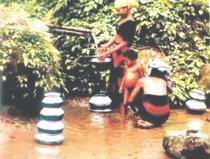 About 5,000 indigenous people residing in two border upazilas (UZs) of Kalmakanda and Durgapur suffer a lot due to lack of pure drinking water.
Because of absence of tube-well or pond, most of the people drink contaminated water of fountains rolling down from the neighbouring India. As a result, they suffer from various intestinal and other water-borne diseases throughout the year.
Different NGOs work here to improve livelihood of indigenous people but no organisation came forward to solve the scarcity of water. Tube-wells cannot be installed or ponds cannot be dug due to high land here, according to
officials of leading NGOs including World Vision Bangladesh. Pure drinking water can be supplied in the area through pipes connected with deep tube-wells installed at plane land, they added. ((Photo: A tribal woman collecting water from a fountain rolling down through Meghalaya in India. It is a common scene in the bordering upazilas of Durgapur and Kalmakanda. Most of the inhabitants suffer from different water-borne diseases due to the phenomenon)
About 5,000 indigenous people residing in two border upazilas (UZs) of Kalmakanda and Durgapur suffer a lot due to lack of pure drinking water.
Because of absence of tube-well or pond, most of the people drink contaminated water of fountains rolling down from the neighbouring India. As a result, they suffer from various intestinal and other water-borne diseases throughout the year.
Different NGOs work here to improve livelihood of indigenous people but no organisation came forward to solve the scarcity of water. Tube-wells cannot be installed or ponds cannot be dug due to high land here, according to
officials of leading NGOs including World Vision Bangladesh. Pure drinking water can be supplied in the area through pipes connected with deep tube-wells installed at plane land, they added. ((Photo: A tribal woman collecting water from a fountain rolling down through Meghalaya in India. It is a common scene in the bordering upazilas of Durgapur and Kalmakanda. Most of the inhabitants suffer from different water-borne diseases due to the phenomenon)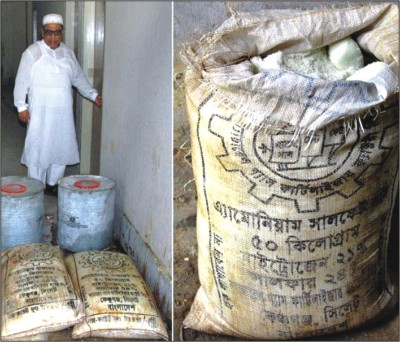 Three employees of Gaibandha Municipality were suspended on Friday for allegedly using ammonium sulphate in drinking water at a treatment plant.
Local people caught the employees, Nur Hossain, Modhu Mia and Hafizur Rahman Hiru, while they were using chemical fertiliser in water instead of aluminium sulphate at the water treatment plant at Masterpara in the town. They were later handed over to local councillor Motiur Rhaman Liton.
Three employees of Gaibandha Municipality were suspended on Friday for allegedly using ammonium sulphate in drinking water at a treatment plant.
Local people caught the employees, Nur Hossain, Modhu Mia and Hafizur Rahman Hiru, while they were using chemical fertiliser in water instead of aluminium sulphate at the water treatment plant at Masterpara in the town. They were later handed over to local councillor Motiur Rhaman Liton.
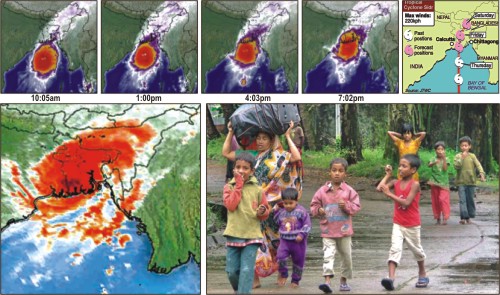 Cyclone Sidr-battered families in the coastal Upazila of Dublar Char have been found to dig makeshift wells to meet the immediate need for water to drink and cook food, as the island is surrounded by brackish water of the Bay of Bengal. The situation is more desperate in other areas of the worst affected districts where sweet water ponds have either been filled with saline water or extremely polluted by decomposed bodies, carcasses of animals, tree branches and leaves. Most hand tube-wells, the sources of safe drinking water, have been rendered out of service by the cyclone.
Cyclone Sidr-battered families in the coastal Upazila of Dublar Char have been found to dig makeshift wells to meet the immediate need for water to drink and cook food, as the island is surrounded by brackish water of the Bay of Bengal. The situation is more desperate in other areas of the worst affected districts where sweet water ponds have either been filled with saline water or extremely polluted by decomposed bodies, carcasses of animals, tree branches and leaves. Most hand tube-wells, the sources of safe drinking water, have been rendered out of service by the cyclone.
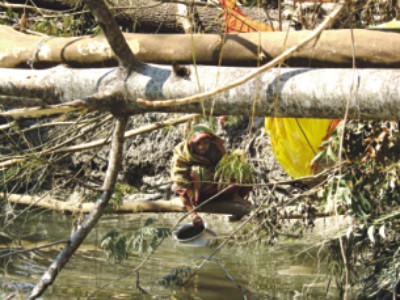 A woman at Southkhali in the Sidr-affected Bagerhat collects highly polluted water for domestic consumption from a pond still containing dead chickens and fishes.
When asked where he got this water from, Hossain said it was from the canal. In the same canal floated dead bodies of people till they were buried. But dead chickens and fish still remain.
A woman at Southkhali in the Sidr-affected Bagerhat collects highly polluted water for domestic consumption from a pond still containing dead chickens and fishes.
When asked where he got this water from, Hossain said it was from the canal. In the same canal floated dead bodies of people till they were buried. But dead chickens and fish still remain.